WURLITZER MUSIC HALL
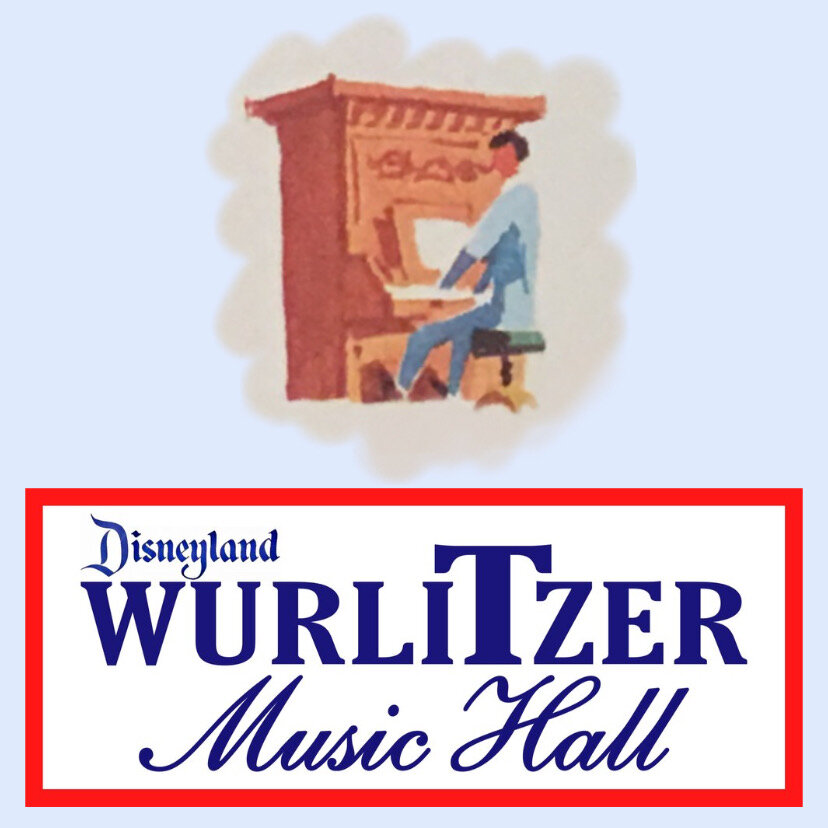
(July 17, 1955 - September, 1968)
During 1954, Walt was searching for participants to lease shop and restaurant spaces at Disneyland, and help generate the necessary capital to fund construction of Disneyland. In a synergistic relationship, the companies (in turn) could sell their products and advertise their corporate names in the Park. By July 1, 1954, George Whitney of Disneyland, Inc. directed Amusements, with Ron Miller overseeing analysis, philosophy, capacities, planning, operator training, and amusement procurement. By July 1, 1954, Russel Tippett of Disneyland Inc. Advertising oversaw Exhibitor’s Space Sales and Lease Agreements. Disneyland Participant Corporate Sponsors were carefully selected. High quality, long term corporate sponsors would provide incremental income that enabled Disneyland to enhance its show and attractions, offset some operating expenses, and capitalize on marketing opportunities.
Many of these were turn-of-the-center business pioneers. Years later in 1958, Bank of America appraisers figured of the total income received from leases, 16.02% was derived from the selling of advertising rights and 40.12% from the leasing of space to concerns whose main reason for occupancy is for advertising purposes. The remaining 43.86% of the lease income was derived from stores that sell various products and food. Clearly, these lessees would provide the needed income.

Wurlitzer Stationary Letterhead with Address; According to the letterhead (on stationary contemporary to their Disneyland sponsorship), Wurlitzer was “the name that means music” in Disneyland!
“Participant Sponsorship”
Soon, the Rudolph Wurlitzer Company - “the name that means music to millions” became “the name that means music in Disneyland”, when it became a free exhibit on Main Street U.S.A. during Disneyland’s first decade and beyond! As a result, “shopping has been a part of the Disneyland scene since opening day, 1955, when just 45 employees worked in the Park’s five stores and stands,” according to Disney News (Fall, 1966). The same publication called Walt Disney’s “Magic Kingdom actually… like a huge specialty shopping center, with thirty Disney-operated stores catering to every taste and purse. In addition, some of America’s most famous ‘name brand’ merchandise is sold in the stores of Park lessees.”
“Design”
“Disneyland is unique in that some of the world's foremost creative artists and architects control all design at Disneyland.
“Architectural Designs by Lessees”
Disneyland, Inc. printed materials for Lessees detailing specifications for architectural designs of exhibit spaces. These were revised by March 16, 1955 and issued to Lessees.
All of the interior architectural drawings were done by competent registered architects or an approved display house of the lessee's choice. All of the designs submitted by the lessee's architect, whether for buildings or construction of interiors in DISNEYLAND, were approved as to the theme and general plan of DISNEYLAND as established by WED Enterprises, Inc.
Three sets of preliminary drawings were furnished DISNEYLAND, Inc. as soon as possible after signing of the lease. Two sets were retained by DISNEYLAND and one set was returned to the lessee’s architect with any revisions noted thereon and stamped “APPROVAL TO PROCEED TO FINAL DESIGN.” This stamp when properly signed and dated constituted the lessee’s authority to proceed with the final drawings.
The Lessees revised their final drawings to incorporate any revisions noted on the approved preliminary drawings, and submitted three sets of the revised drawings to DISNEYLAND. One set was returned to the lessee’s architect and any revisions noted thereon are to be incorporated on the original drawings. When the lessee had incorporated the final revisions on the drawings, two sets of transparent ozalids were forwarded to DISNEYLAND for approval. DISNEYLAND would stamp both sets “FINAL DESIGN APPROVED” and “LESSEE’S CONTRACT DRAWINGS”, and return one set to the lessee who could then release drawings for bid and/or construction.

While Walt Disney stands framed by the covered waiting room of the Disneyland railroad station note Wurlitzer under construction; Wide World Photo B-34754 ; 6892-aje-6/9/55
“Construction”
“When the giant earth-moving undertaking was completed, the building crews took over. Soon, the rat-tat-tat of riveters was shattering the air, and sparks were flying from welders’ torches as the steel frameworks, capable of withstanding the ravages of time and the elements rose above the newly formed ground. While carpenters hammered and masons laid row upon row of brick and stone and mortar, the permanent buildings began to take shape and form,” according to “The Disneyland Story” published 1955. One of the first buildings to be constructed was the Main Street Opera House, which was used as the Mill. Here, the woodwork of Disneyland was generated - from the functional to the aesthetic! Approximately three and one-half million board feet of lumber went into the Park’s construction. Much of the wood was processed here by McNeil Construction (which formerly constructed Walt Disney Studio sound stages in 1947 and 1953), and under the direction of George Mills Sr. (the Prime General Contractor and Mill Foreman). Then, under the direction of Joe Fowler (Construction Supervisor), as well as Charles Alexander and Ray Conway (Construction Field Supervisors), the lumber was soon fashioned into the framing belonging to the very first buildings constructed at Disneyland - primarily the Main Street Complexes (on each side of the street).
F.M. Franz, manager of operations for MeNeil Construction expressed: "We feel sure there has never been anything built like this in Southern California, or elsewhere in the United States. Many of the items were constructed from artist’s sketches.” In constructing each building, a concrete foundation and slab floors were prepared, followed by wood frame construction (while store units would have a combination wood and rigid steel frame). ”The first fabricated steel for the Main Street buildings arrived November 8 and was erected,” according to the narrator of “Disneyland - The Park,” a Disneyland anthology television series excerpt, first aired 1957 and Disneyland LINE (November 22, 1979).
Newbery Electric Corporation gave electricity to Disneyland. “The electrical installations were supervised by Roy J. Gruendler, manager of Newbery's Orange County district office located at 1335 Santiago Ave, Santa Ana.”
According to inserts published in area newspapers during July of 1955, Disney buildings were roofed by Pioneer Roof & Shingle Company (then located at 608 Mateo Street, Los Angeles, California; 7522 Westminster Avenue, Westminster, California). The roof covering was a variable, dependent on the architectural design.
As of June 2, 1955, C.V. Wood Jr. sent an Inter-Office Memorandum to Walt Disney regarding the best estimates that could be obtained at the time regarding the completion status of individual sections of the Park and Opening Day. C.V. wrote: “Building #611 - Wurlitzer: Estimated to be completed by the first of July. Electric Signs: All are in work - with the exception of the shoe store and the Bank of America, all will be completed.“
The building (as each on Main Street U.S.A.) possessed complete fire sprinkling systems. By June 30, 1955, related Disneyland Site Work Fire Protection Utilities Plot Plans were prepared for Disneyland Inc., by J.E. Thomasson of WED Enterprises Inc.
All fixtures were placed in their correct motif and many light fixtures of Disneyland were authentic antiques.
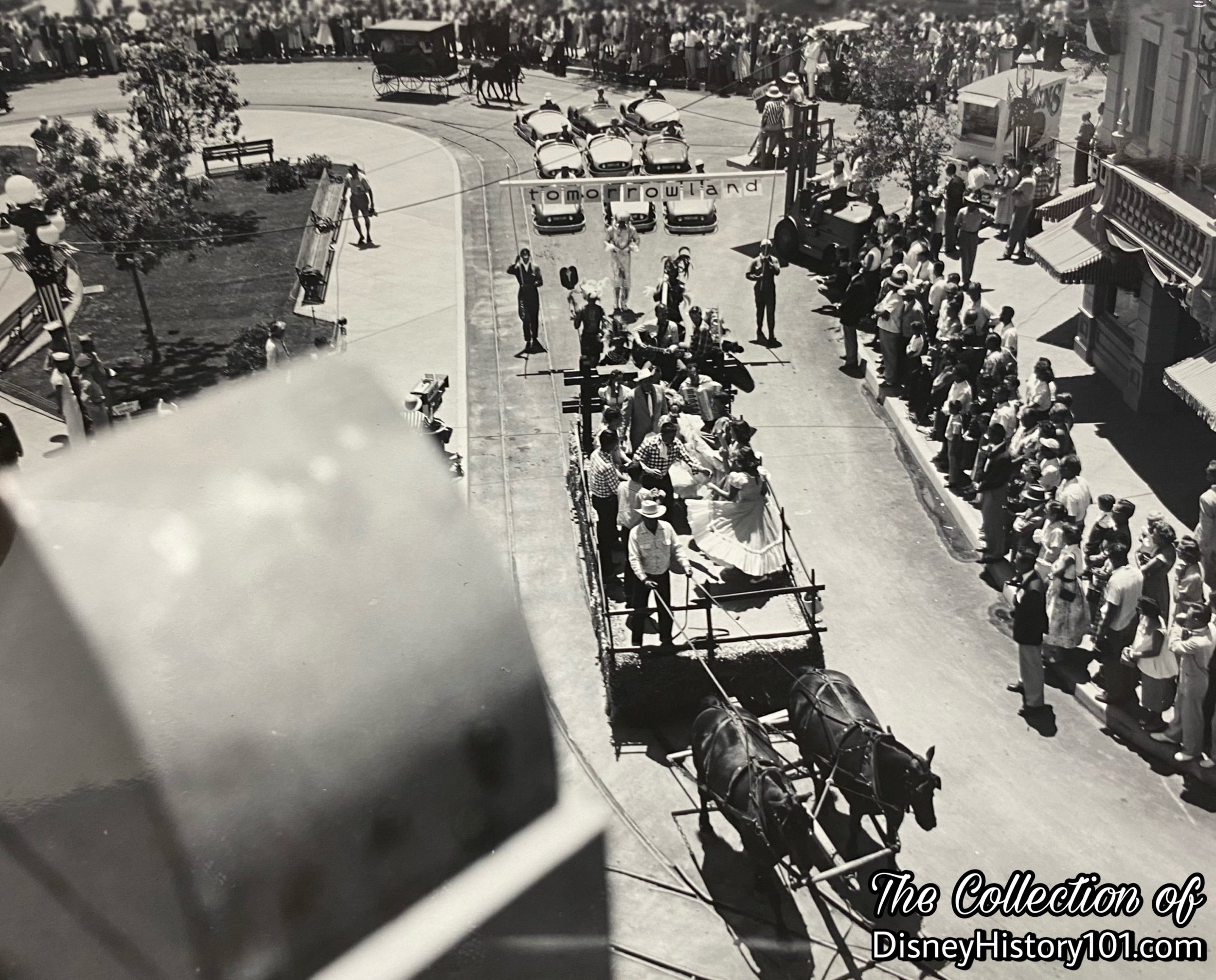
The view from the roof of Wurlitzer.
“Press Preview Day”
A contributing writer of The Daily Oklahoman (who visited on July 17, 1955) noted: “The guests walked into a city square of the 1900 era, bounded by an old time railroad station, city hall and fire station, opera house and other vintage merchant houses.” One such merchant house was the Wurlitzer Music Hall, which opened at 100 Main Street (on the East side of Main Street’s Town Square), on Disneyland’s opening day, July 17th, 1955. Above, Trooper Lights and Camera men were perched from the roof of Wurlitzer, as during the opening day parade in 1955.

A press release photo depicts the Grand Opening of Wurlitzer at Disneyland; ©️Walt Disney Productions.
“Dedication”
Walt described to Bob Thomas (of Associated Press), “some industries will have exhibits, but all of them must be in keeping with the era.”Wurlitzer was sponsored by one of the United States’ “old reliable firms, which have been in business fifty years or more. Here they can show how they started and reproduce their first place of business.” [Disneyland Prospectus, 1954]
The Wurlitzer free exhibit and shop was situated on two parcels measuring (915 square feet; 194 square feet) a total of 1,109 square feet. These two parcels were located between the Maxwell House Coffee Shop and the Wonderland Music Store for more than a decade, until September of 1968.
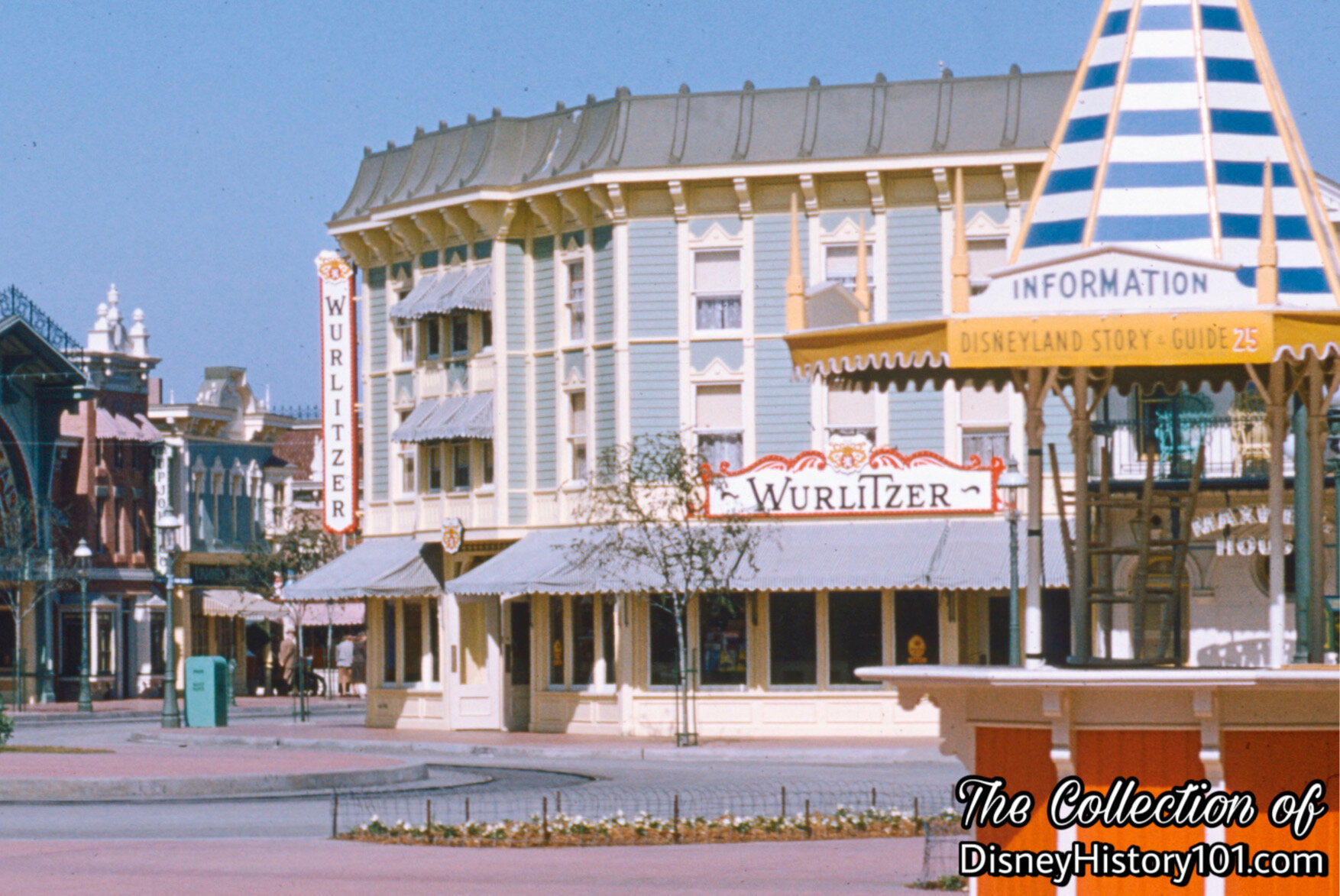
Wurlitzer, 1956.
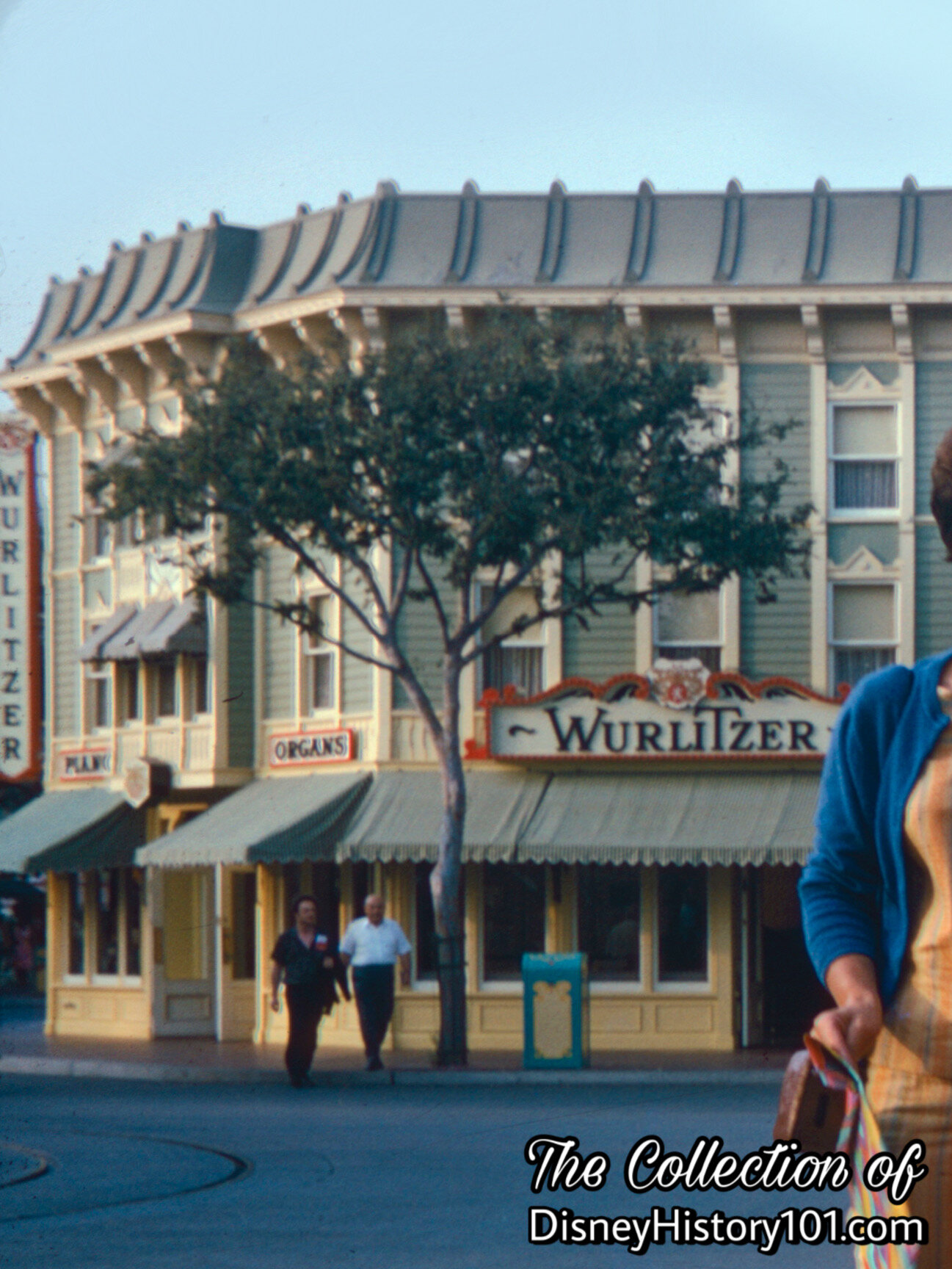
Wurlitzer Music Hall
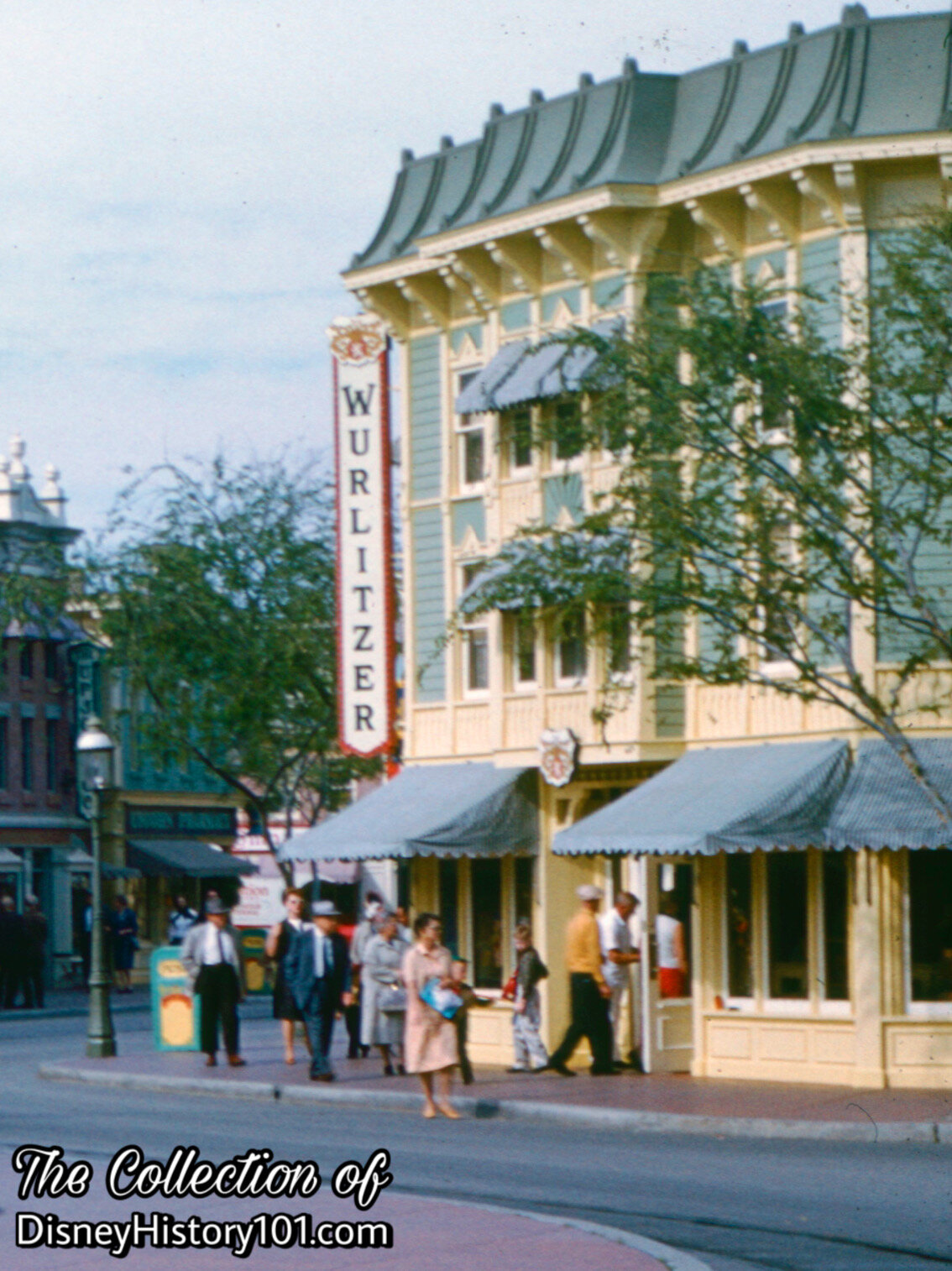
Guests Head Through the Doors of Wurlitzer at Disneyland

Now, “Disneyland is a place to have fun… and with the fun it is a place where you can learn,” according to “Disneyland, U.S.A.” (published 1958, for potential Participants). From 1955 to 1968, The Wurlitzer Company of Disneyland was home to a number of displays and exhibits. Once through the doors, guests could view “Wurlitzer’s Victorian and Modern Displays” (which were entirely separate features from “Wurlitzer’s Organs and Pianos” according to “Your Guide to Disneyland”, published 1955).
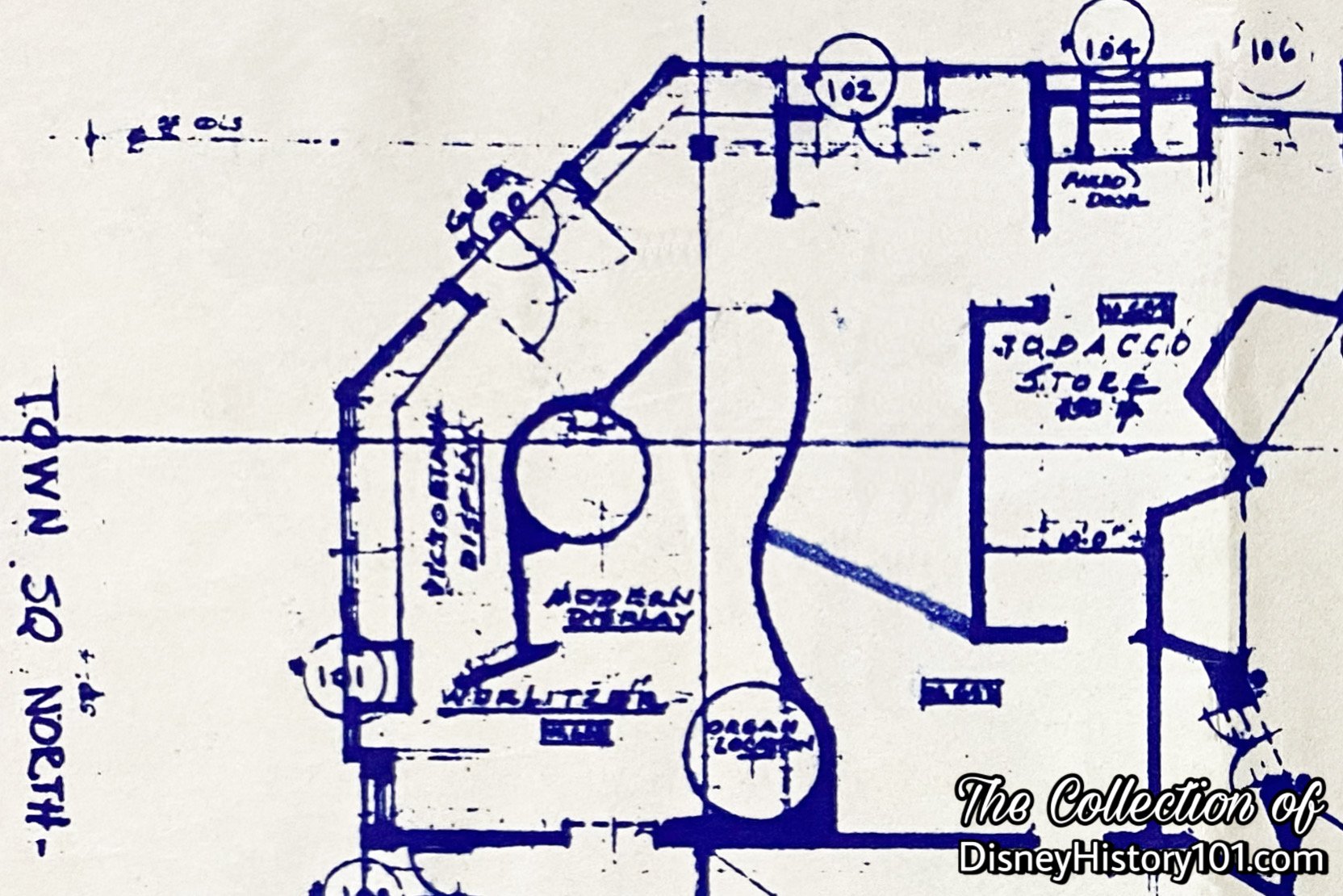
Note the Victorian Display, Modern Display, and Organ Location on the “Plan for Units 300 to 400 & 500 to 600” designed by WED Enterprises, Inc., c.1955.
Window displays have always played an important role -communicating to guests the essence of a shop and were designed to invite guests into the store. These may be animated or still and would also include props used for display purposes. As early as 1955, (even from outside) guests could enjoy exhibits, like the Martin Band Instrument Company-sponsored window displays about “the role of band instruments in the good old days. One of the windows , all of which have dioramic type backgrounds, features…German Band figures…Other windows depict a musical professor and his pupil, a band concert, and a reproduction of band instruments being made in Martin’s original shop in 1904.”
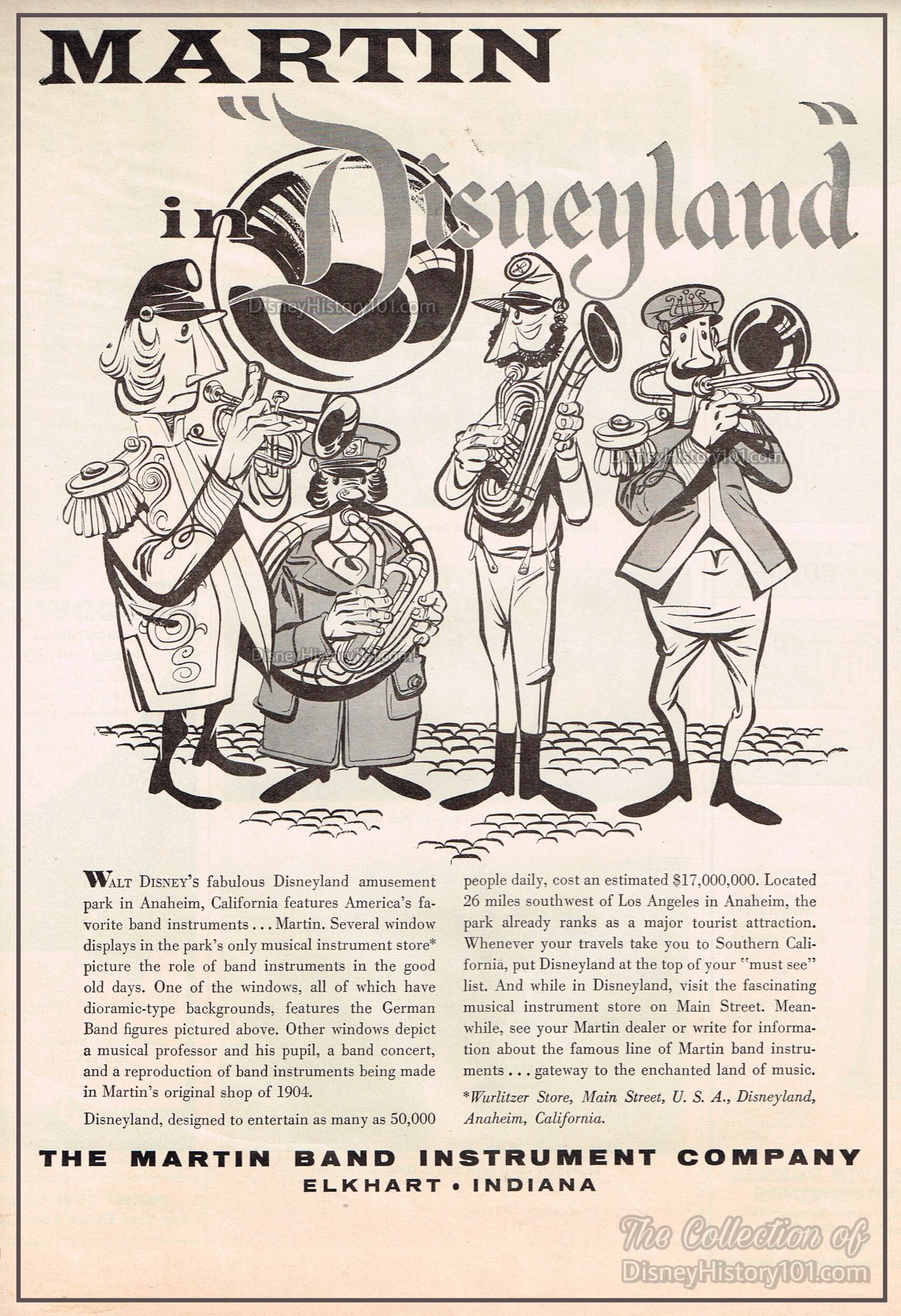
Martin Band Instrument Company Advertisement, (December, 1955)
This Martin Band Instrument Company advertisement (published during the winter of 1955) preserves one of the Wurlitzer Music Hall’s early diorama window displays. Though the Martin Band Instrument Company was not a Disneyland sponsor, their products were sold through Wurlitzer Music Hall at Disneyland.
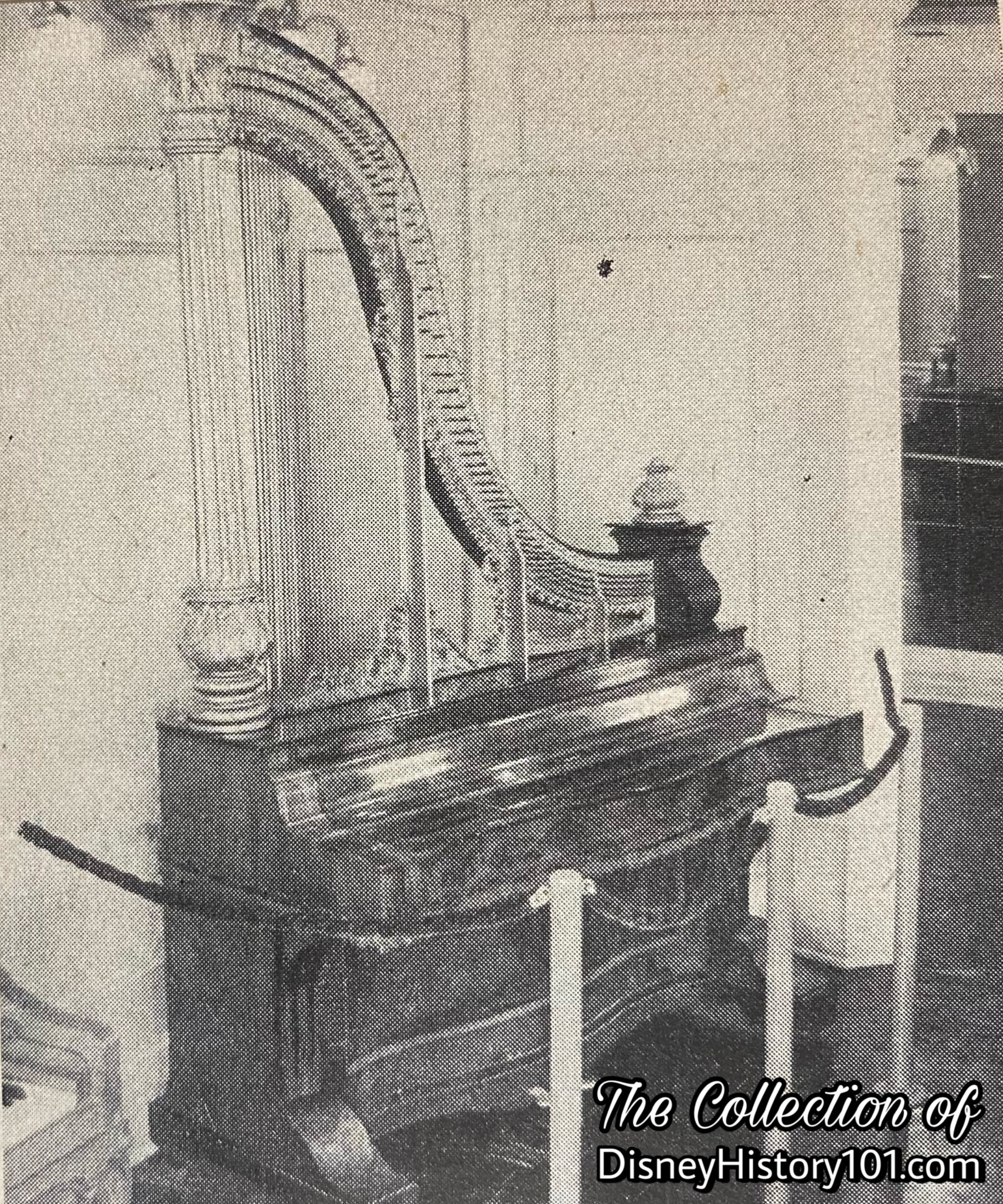
A c.1838 Harp Lyre Piano as Seen in "Rare Antiques of Disneyland", The American Home (September, 1956), page 15 (excerpt)
“Wurlitzer’s Victorian and Modern Displays” (similar in style to the neighboring Upjohn Pharmaceutical Company’s “Victorian and Modern” Exhibits) showcased antiques! There was a 1838/1837 black walnut Harp lyre Piano (1 of 3 known to exist in the United States; pictured below), a Melodian built 1869, and a Piananino (the predecessor of the modern day jukebox dating from 1905).
There was even a rare Orchestral Theater Pipe Organ “Toy Counter” which had the capability to produce sound effects, and was used during the silent era of film but scrapped when “talkies” came into existence. “As Dee explains the ‘Toy Counter,’ the first-class silent movie houses used Wurlitzer Orchestral Pipe Organs to accompany their feature pictures. Attached to these organs and op erated by toe buttons or keys was the ‘Toy Counter,’ which supplied amazingly realistic sound effects to accompany the music. The organist had at his com mand such varitoned effects as the bass drum, snare drum, kettle drum, castanets, tambourine, galloping horses, sleighbells, bird whistle, fire gong, door bell, and, for particularly dramatic moments, the crash cymbal. Very few of these ‘Toy Counters’ are still in existence. When the ‘talkies’ replaced silent pic-tures, most theater pipe organs were sold to churches. The sound effect machines had no place and were scrapped.”
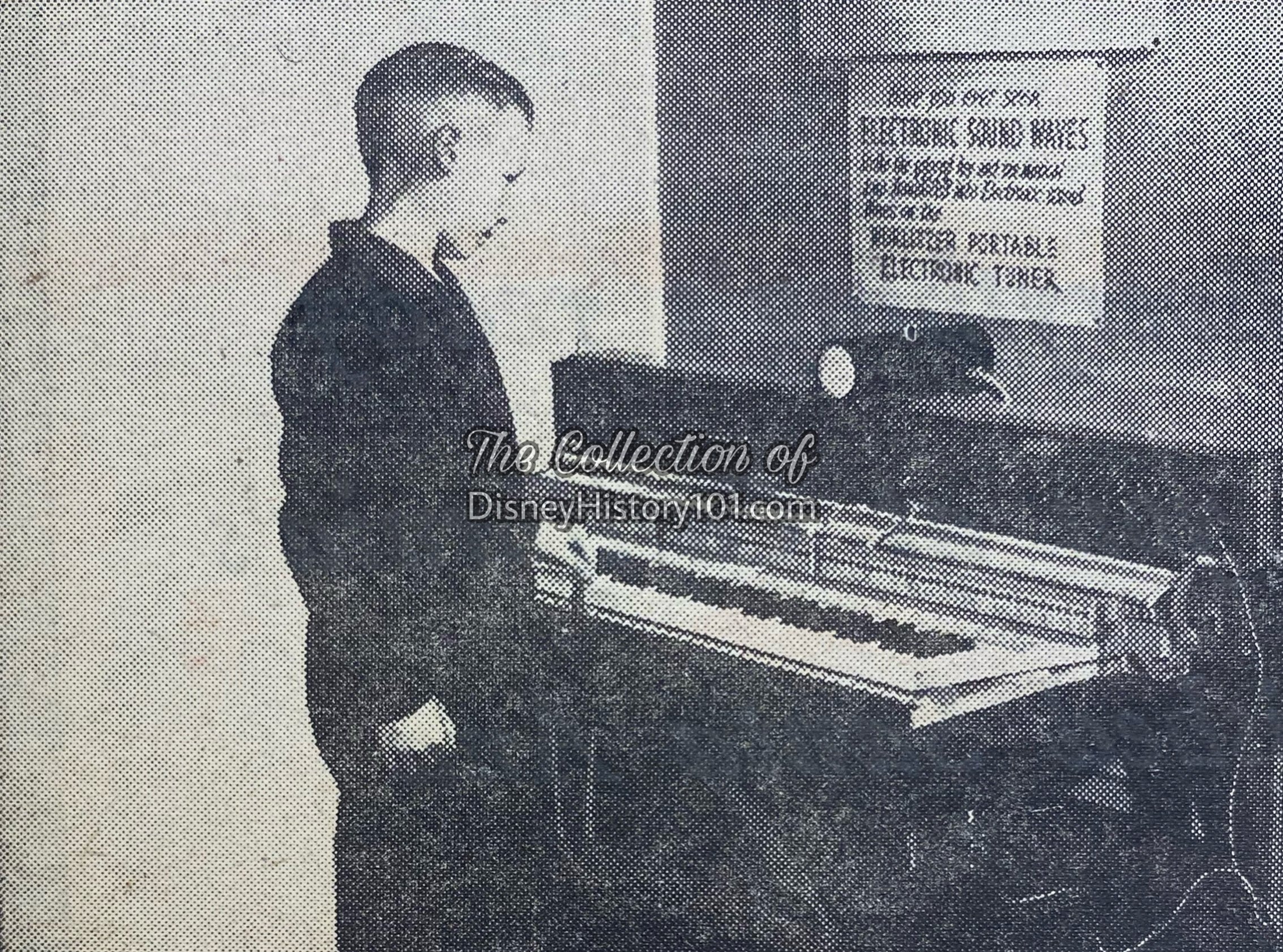
The Disneyland News Vol.1, No.6 (December 10, 1955)
On the scientific side, there was a cutaway piano which allowed guests to “see as well as hear a piano note.” There was also an oscilloscope wired to a piano which distorted notes from the piano key into waving motions that looked similar to Fantasia’s “Meet the Soundtrack” Intermission segment. This was an interactive exhibit, which was so demonstrated for guests, that (according to Disneyland News, December 10, 1955), “Dee estimates that this key, a middle F note, has been struck some 3,500,000 times since opening day, July 18.” This is an impressive figure, considering that Disneyland attendance for that first six-month period was 1.9 million. All of these exhibits were valuable teaching tools for the teachers who would bring their students to Disneyland on field trips during the 1950s and 1960s. Considering all of these displays, it is easy to see why by the year 1958, the Wurlitzer Shop was considered one of 15 free educational shows and exhibits at Disneyland.
By 1969, these exhibits were among 15 old-time band organs and pianos at Disneyland, some of which dated back to 1890. There just weren’t any replacement parts for these rare antiques. So, ARCADE MAINTENANCE performed the necessary versatile, creative, and inventive mechanical repairs.

WURLITZER MUSIC HALL SHOWROOM
Wurlitzer created tangible memories for Guests through Merchandise and Show. Now, after perusing all these exhibits, Guests could test the grand piano, and peruse electric organs and pianos on display in the Wurlitzer Music Hall Showroom. Here, Guests could sample the merchandise - current Wurlitzer Co. Martin and Peddler brand pianos and organs. On display were also the newest 1955 Wurlitzer Electronic Portable Piano (a model that had its first west coast showing at Disneyland) and both new and traditional electronic organs. After looking over the models, Guests could acquire information about aforementioned sponsor (the Martin Band Instrument Company of Elkhart, Indiana). Finally, Guests could purchase pianos, organs, and jukeboxes from the Wurlitzer Music Hall.

THE WURLITZER HALL SHOWROOM
In the alcove of the wall, you’ll notice a 2800 series Wurlitzer Jukebox Arcade, carrying hi-fidelity and stereophonic sound. One of Wurlitzer’s popular models was a jukebox with a 200-song capability. If guests couldn’t take one home, the jukebox was licensed as a small coin-operated souvenir bank that was also sold in Wurlitzer Music Hall.
Wurlitzer was renowned for its jukeboxes and phonographs, and many other models appeared on the showroom floor - the Wurlitzer Centennial Model 1900 (1956), the remote controlled Model 5207 “Wall Box” with a 104-song selection (1956), to name a few. Wurlitzer also manufactured and sold a number of “Corner Speakers” and “Wall Speakers”in a variety of attractive colors, for high acoustical efficiency! With so much to offer it isn’t surprising that Wurlitzer would soon come to be billed as “the official music of Disneyland” during its era!
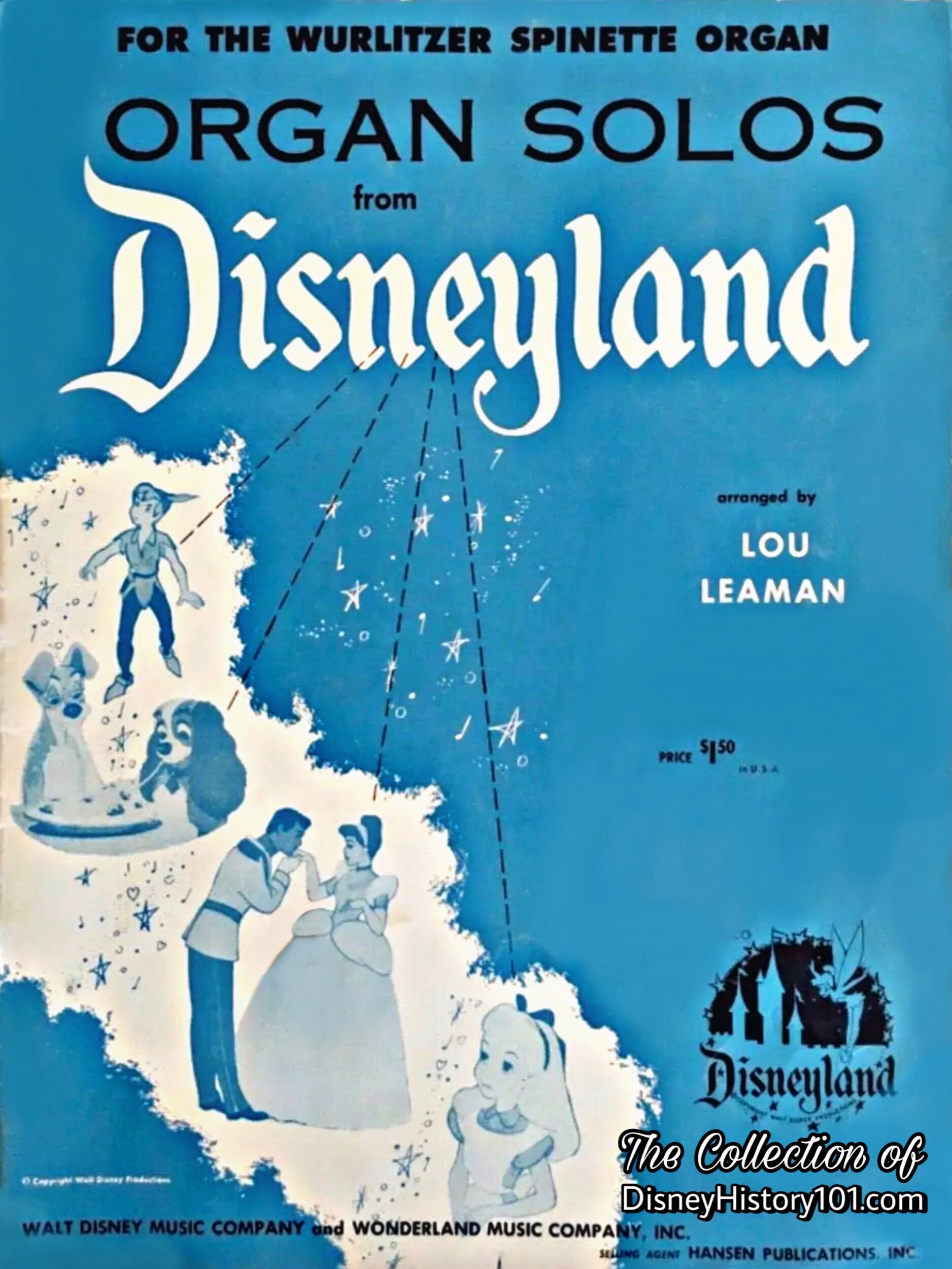
"Organ Solos From Disneyland," by Hansen Publications of New York.
During the era of the Wurlitzer Music Hall at Disneyland, Wurlitzer publications (like the ones pictured above and below) were available for purchase through the Wonderland Music Company (next door to Wurlitzer Music Hall). Some sheet music was produced with the intent of being played on certain models (like the Spinette), while others were published for all Wurlitzer Organs. It’s likely that sheet music like this may have been available for demonstration to guests of Wurlitzer Music Hall at Disneyland!
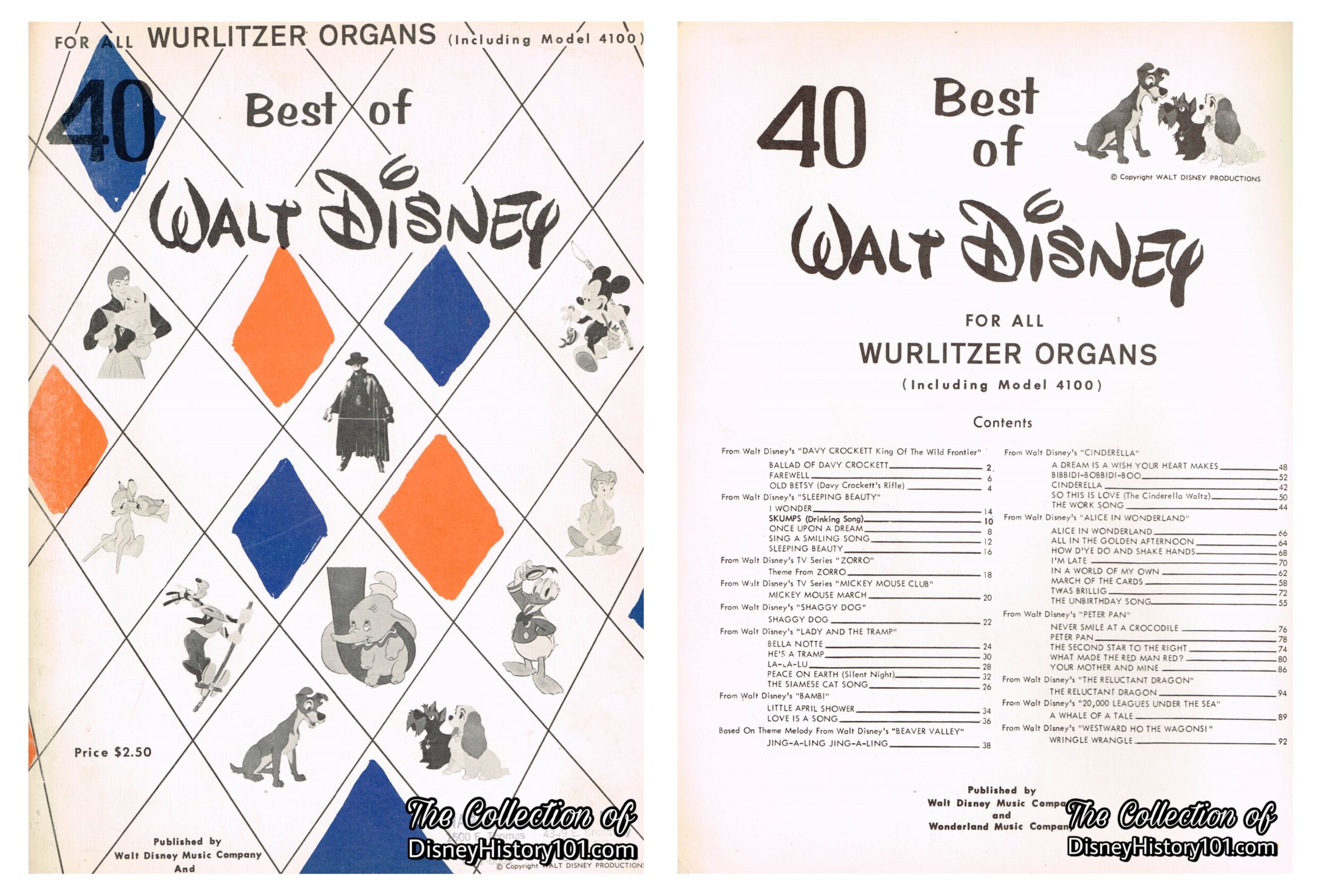
"Best of Walt Disney" For All Wurlitzer Organs, 1959
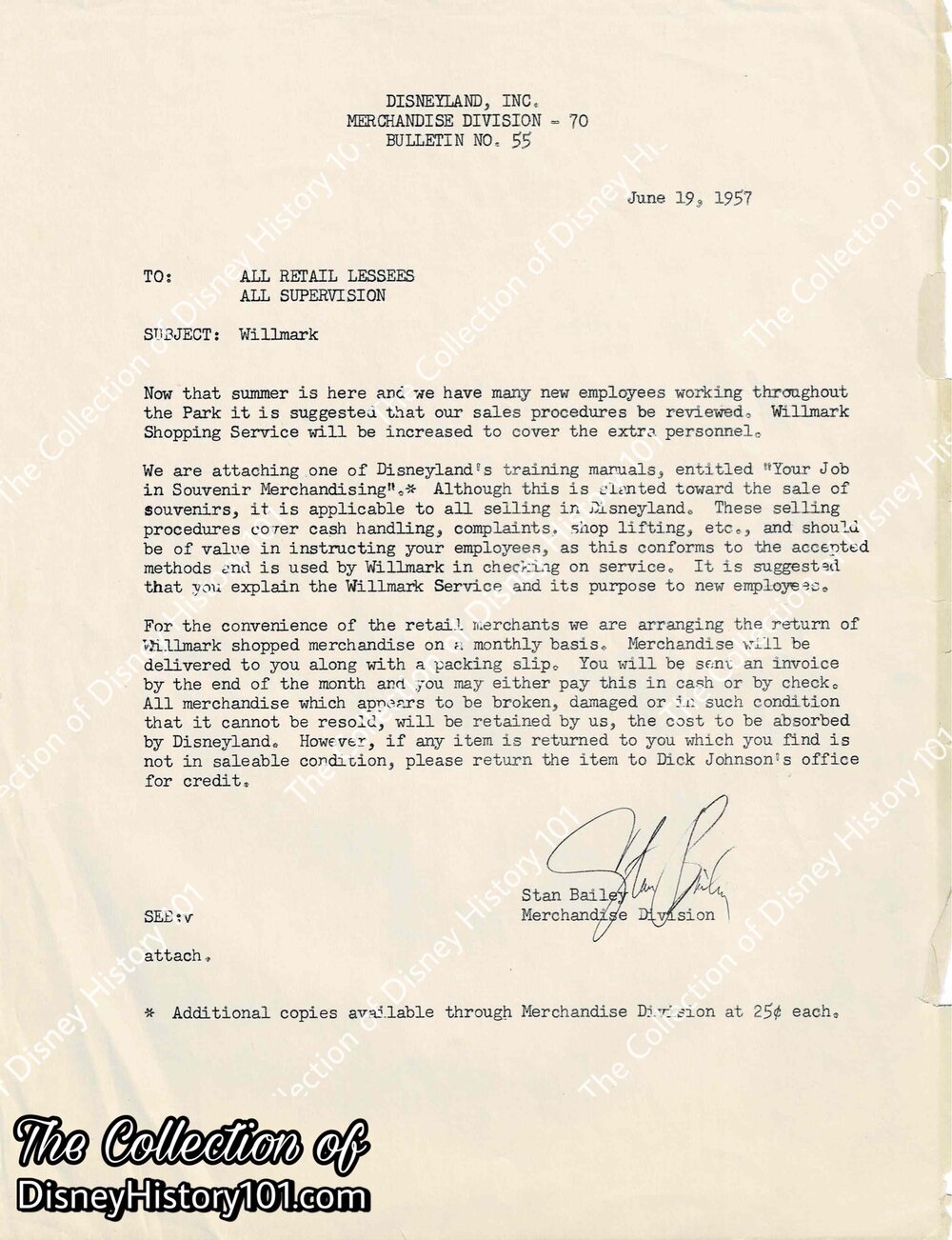
It was about 1957, that Disneyland, Inc. utilized the Wilmark Shopping Service to assure higher levels of quality service in Souvenir Merchandising (which included Wurlitzer).
Few other smaller souvenirs like lighters featuring the Wurlitzer name and slogan “The Name That Means Music to Millions” were also briefly sold in the shop!
The 1957 TWA brochure “Let’s Talk About… My Visit to Disneyland, Anaheim, California: A Note from Mary Gordon TWA Travel Advisor” mentioned: “We learned that to fully explore Disneyland takes two days, so early next morning we were at the gates of the park again. The second day we spent more time shopping in the 50 inviting shops, and the youngsters bought inexpensive souvenirs to take home to friends.”
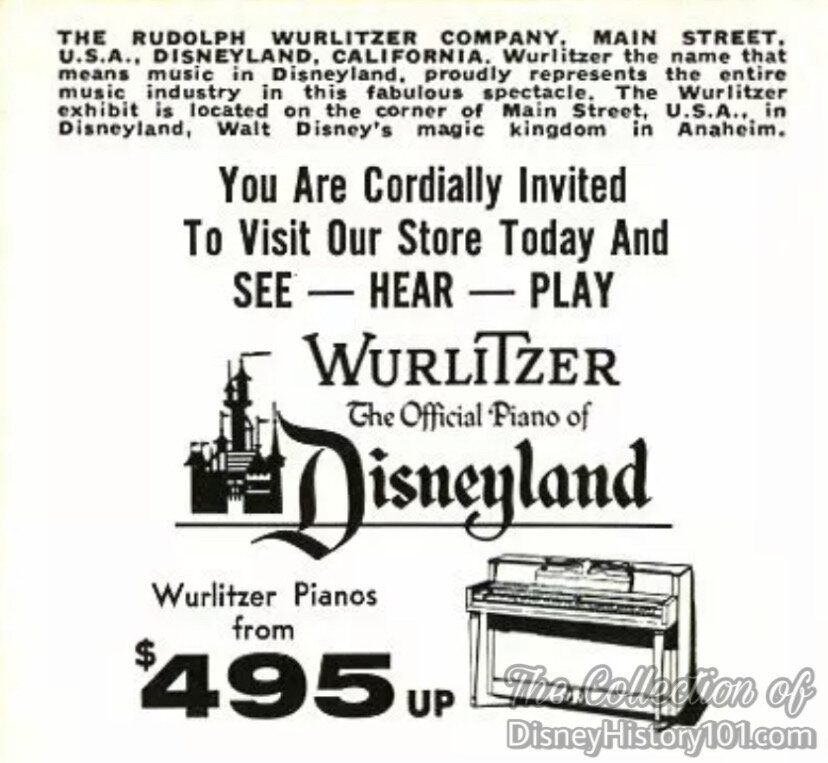
Souvenir Wurlitzer Post Card (Excerpt), c. 1955 - 1959
What was the price range advertised for Guests and potential customers of Wurlitzer of Disneyland? The backs of souvenir postcards (pictured above) advertised the starting prices of Wurlitzer pianos. This is a prime example of “the possibilities for a sponsor to capitalize on this association” with Disneyland. The many ways of “merchandising, sales promotion, advertising, public relations and publicity programs are almost limitless. Regardless of the type of product, goods or services manufactured and marketed by sponsors, the Disneyland association can be effectively and importantly translated into the sponsor’s promotional activities,” according to “Disneyland, U.S.A.,” published 1958. The corporate synergy was good. Institutional lessee The Wurlitzer Company yielded some revenue for Disneyland Inc. - $16,253 for the fiscal year ending September 29, 1957 and $19,717 for the fiscal year ending September 28, 1958.

Wurlitzer Magazine Advertisement, c. 1967
“…And Now A Word From Our Sponsor!”
Wurlitzer was more than a free exhibit at Disneyland. Wurlitzer was “a name that means music to millions” (as this advertisement attests). The company was (and is still) known for its organs and pianos “for church and home,” yet the Rudolph Wurlitzer Company of Tonawanda, New York also manufactured violins, flugelhorns, trumpets, saxophones, guitars, and more! Wurlitzer even manufactured the Music Laboratory Instructor Console (pictured above), which was utilized by high schools, colleges, universities, and other institutions of learning around the country. The Wurlitzer people were always happy to demonstrate one of their fine pianos, organs or stereo consoles - whether guests were just relaxing or furnishing a mansion.
In addition, Wurlitzer offered instructional publications (like the “Wurlitzer Hobby Lesson Course”) - accelerated pop and piano courses compatible with the Wurlitzer Music Library. Soundtracks of Walt Disney Productions were piped through the speakers (e.g. as during May of 1957 when guests could take a listen to the new Studio sound track releases of Bambi and Cinderella).
The Wurlitzer Music Hall at Disneyland even played a part in at least one National Piano Teachers Day event held in Disneyland on October 10, 1959.
With so much to offer it isn’t surprising that Wurlitzer would soon come to be billed as “the official music of Disneyland” during its era!
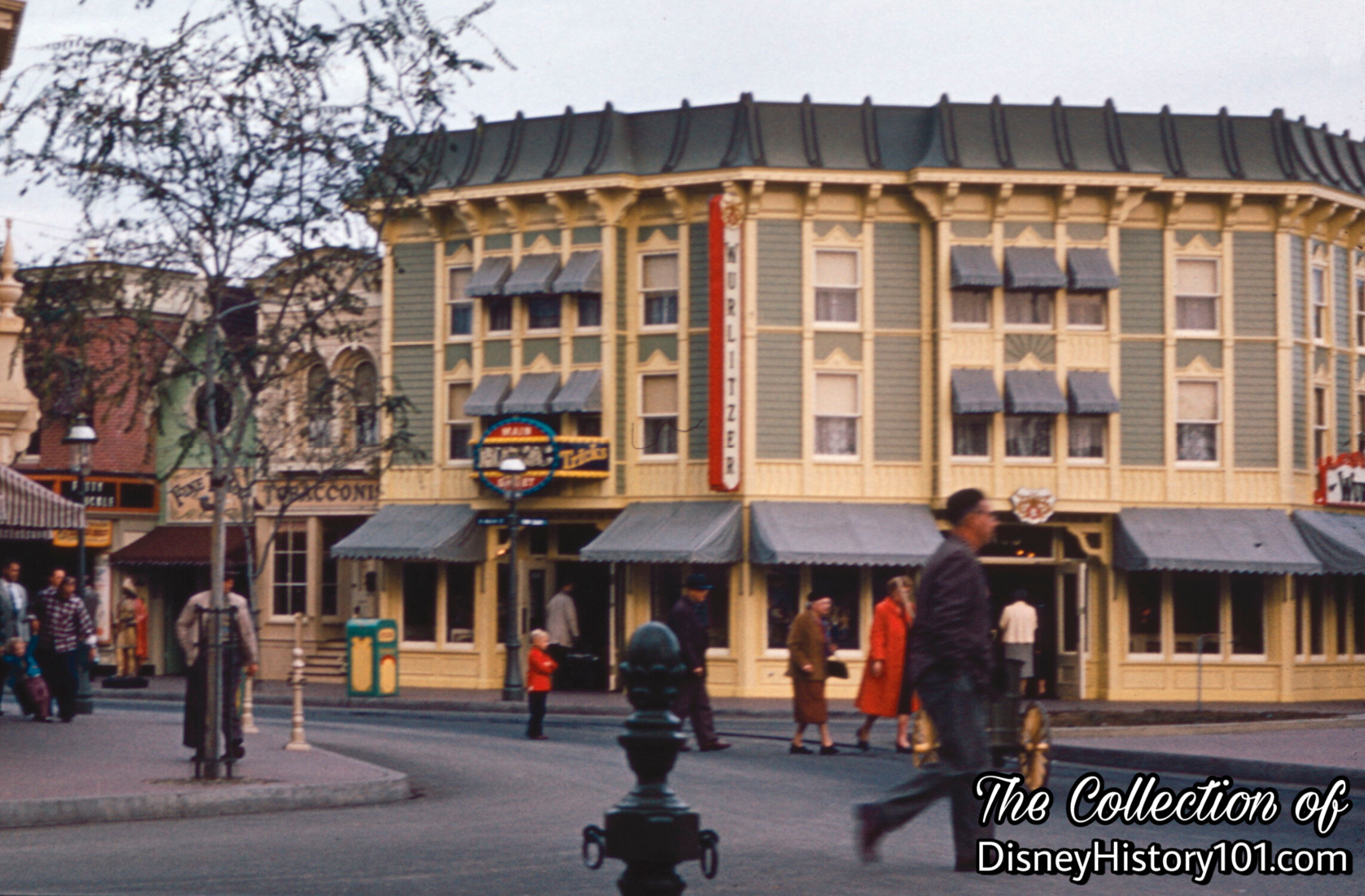
Wurlitzer Music Hall
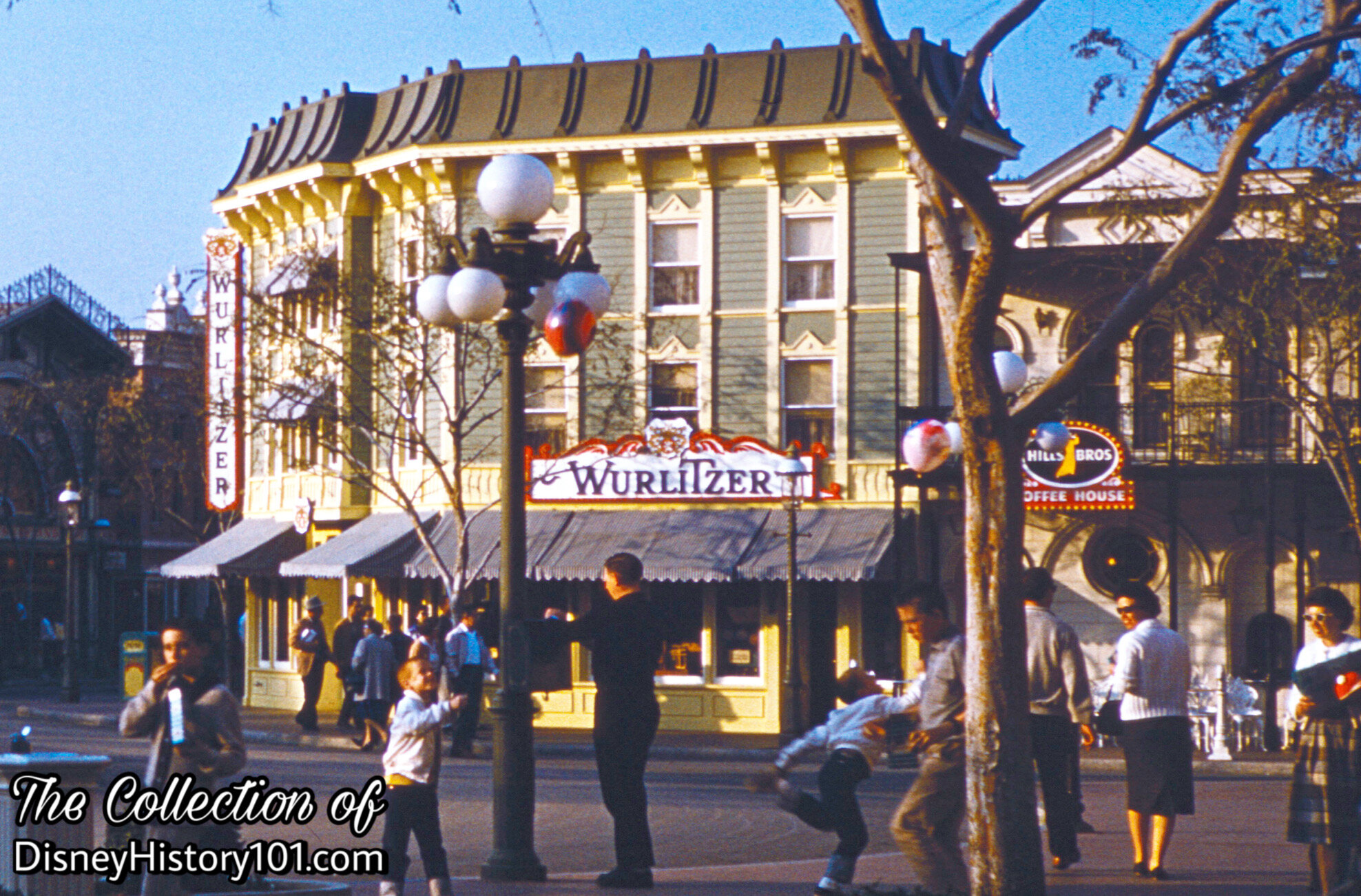
Wurlitzer Music Shop, late 1950s to early 1960s
By October of 1959, the company was (1) of over sixty-eight other firms playing a vital part in the team effort to bring happiness to Disneyland’s Guests. Some were small, specialized individual operators; some were huge companies such as Swift & Co. - the Bank of America - United Paramount Theaters (which you hear as UPT) - Carnation - Richfield - General Dynamics - Crane - and many others. These companies used the park to publicize their wares, leased space in the Park to sell their wares, and Disneyland collected advertising fees from them.

Since the beginning, Disneyland was a miracle of showmanship in many ways! According to “THE DISNEY THEME SHOW - an introduction to the art of Disney outdoor entertainment”: “Important are the sounds which permeate the scene, for without them, the theme show is a silent movie . . . but with them it is a symphony of music, effects, and natural sounds that the finest stereo system in the world can't duplicate. These sights and sounds are provided not only by imagineered attractions and shows, but also through the multi-talented efforts of live entertainers . . . in special musical groups . . . in parades and pageants . . . providing an everchanging backdrop to virtually every area in the theme show.”
Atmosphere Entertainment complimenting the theme of areas was staged to entertain Disneyland Guests on an immediate and personal level. You may recollect hearing a concert emanating from inside the Wurlitzer Music Hall (or, even right outside it’s doors), as you strolled by during a peak season. As mentioned earlier, Wurlitzer was appropriately located “down the street” from Wonderland Music Company, where guests could purchase sheet music of popular songs featured in Walt Disney Studios feature length films and television programming. Much of this sheet music was demonstrated for guests by skilled “Hosts”and “Hostesses” (both managers and employees) of the neighboring Wurlitzer Music Hall.
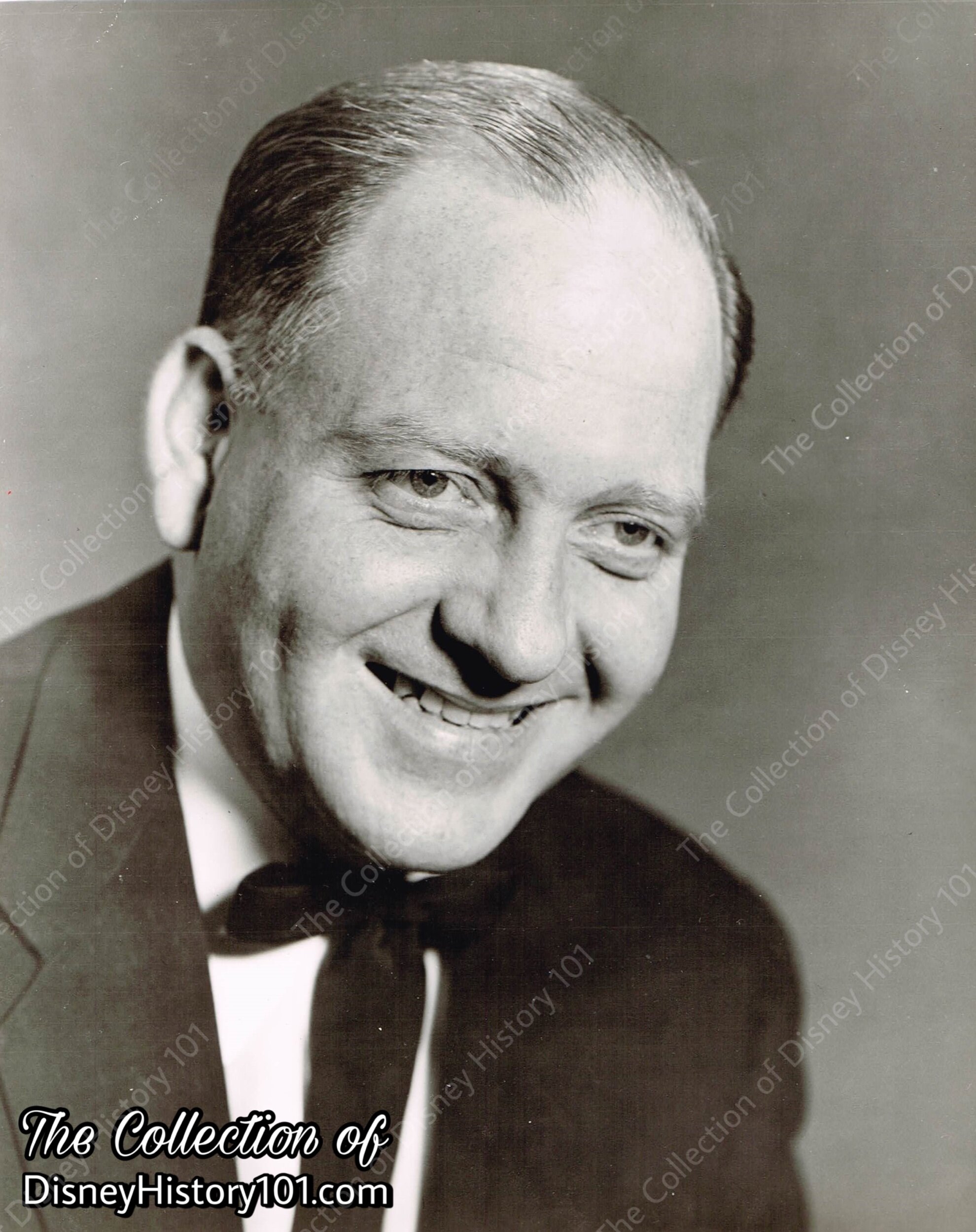
Dee R. Fisher, Wurlitzer Organ Representative, c. January or February, 1962.
“Dee Fisher Takes You to Disneyland”
What better way to sell a product than to demonstrate it for guests? That was exactly what Wurlitzer and Martin and Pedlar, representative Dee Fisher was well known for since 1955 - his recitals inside the Wurlitzer Music Hall (also referred to as the “Wurlitzer Exhibition”). It’s been said that “Disneyland is People,” and Dee was the Wurlitzer manager and certainly the “genial host,” often surrounded by the audiences of each new day whom he personally welcomed into the store. More than that, Dee was creating magical moments for Disneyland Guests. This is evidenced by a photograph, featuring Dee giving one of his concerts, that was featured on the cover of Wurlitzer Organ Review Magazine alongside Mickey Mouse and Minnie Mouse during the late 1950s.
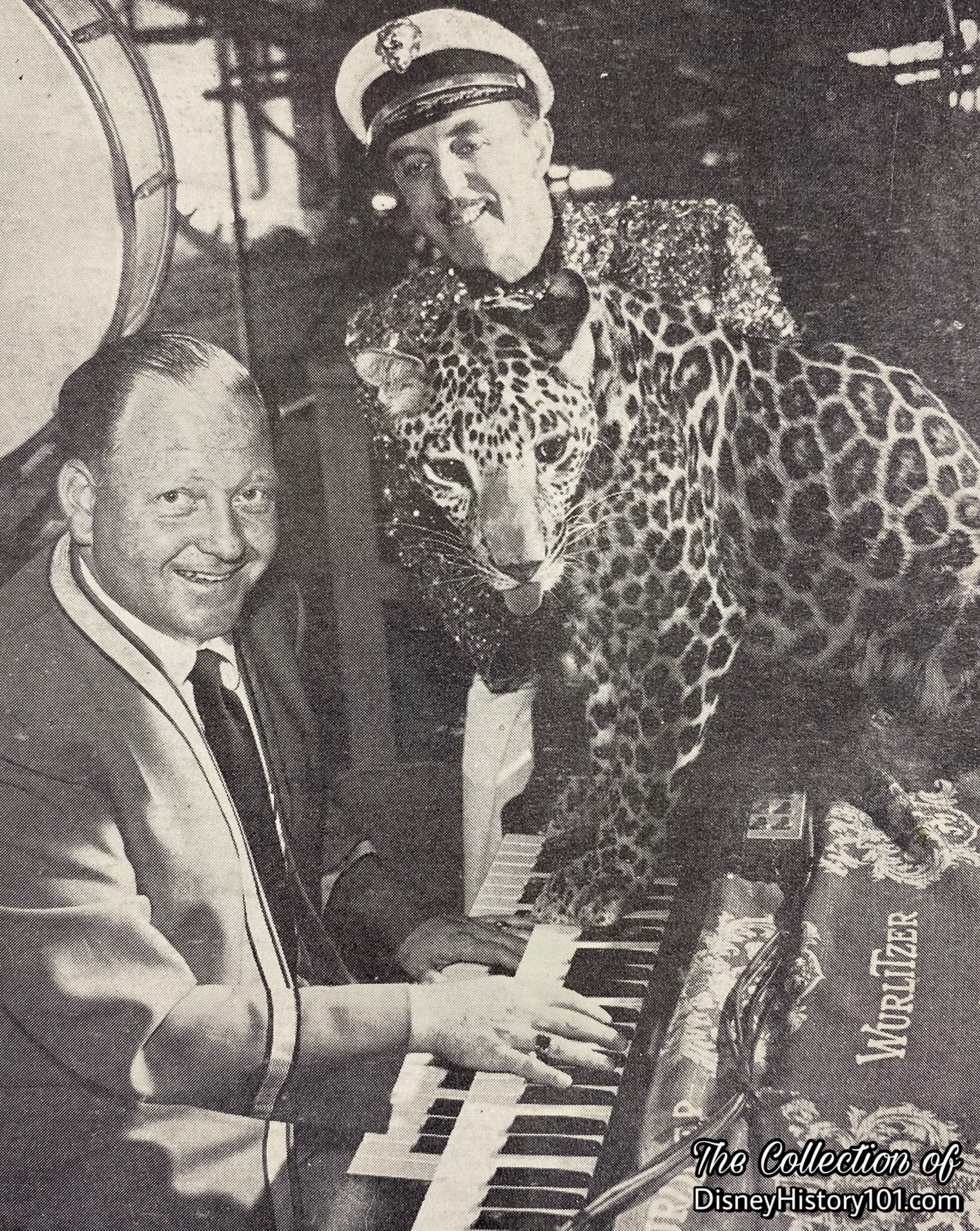
Wurlitzer Store Manager Dee Fisher at the Wurlitzer electronic organ with TABU, one of Professor George Keller's trained cats.
Dee even performed at other locations at Disneyland. For instance, when the popular Mickey Mouse Club Circus headlining act, “Keller’s Jungle Killers” was held over from February 19, 1956 to September 9, 1956, Dee Fisher (of Wurlitzer) provided background music on a Wurlitzer Organ, according to “The Disneyland News” [Vol. 2, No.2 ; published for August, 1956] Dee flew to the Hawaiian Islands to play the mighty Wurlitzer for George Keller's Animal Act between Christmas of 1956 and New Year's Day of 1957. Dee Fisher’s first LP album was recorded on the electric organ in Disneyland, soon released after the first of the year.
Dee Fisher fulfilled the important role as the second president of the Disneyland Merchant's Association (following the term of Les Wagman of the Bank of America), announced at a meeting held on January 25, 1956. However, like most other Disneylanders, Dee enjoyed DRC activities during his free time. Dee served as the Disneyland Toastmasters Club President from 1956 to 1957. Speaking of DRC activities, Disneylander area merchant Wurlitzer was a sponsor of the championship Disneyland baseball team of 1957.
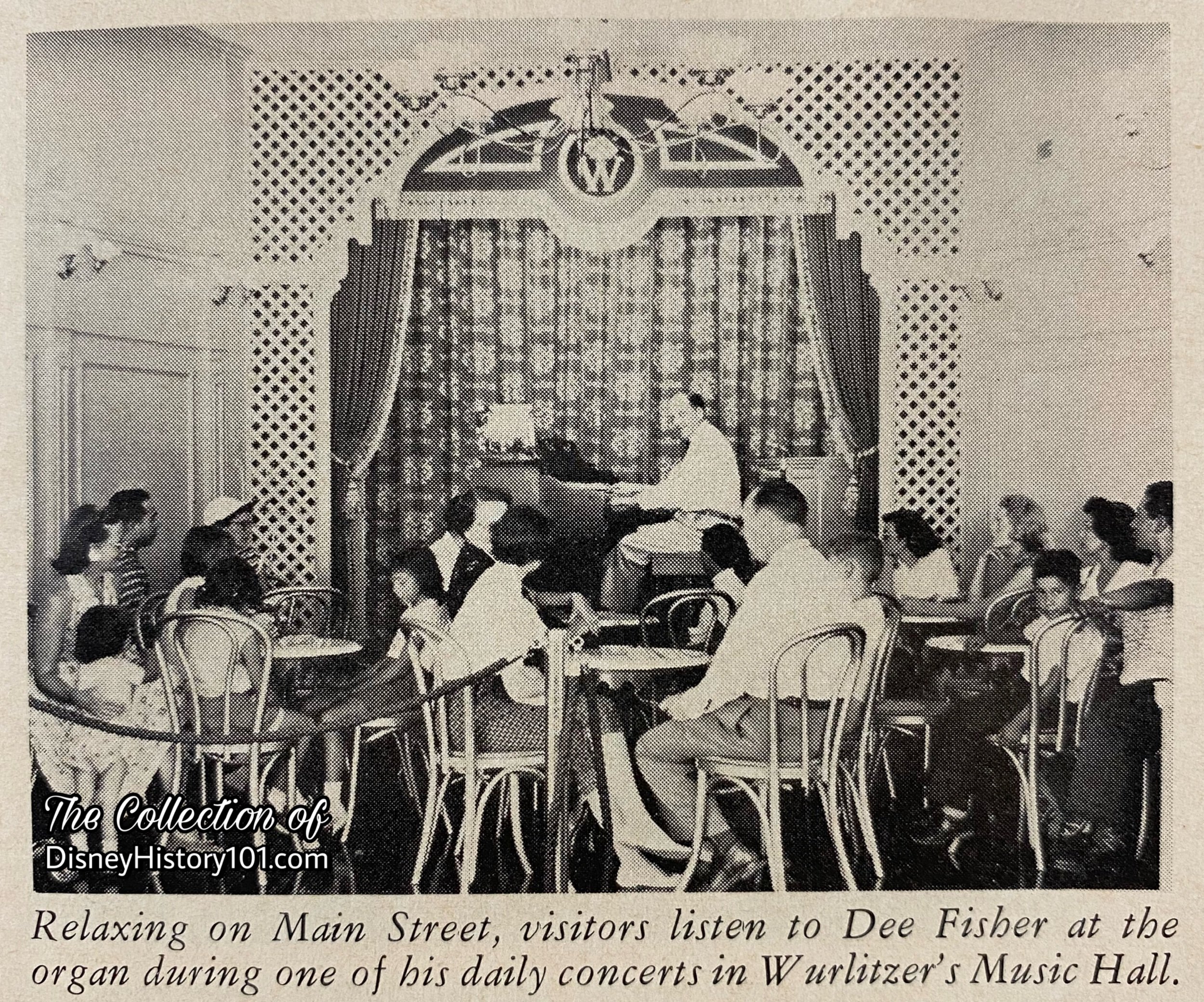
Disneyland Holiday magazine excerpt.
During 1957, Wurlitzer Music Hall received a major redesign and refurnishing. One product of the redesign - Wurlitzer Music Hall’s small stage (surrounded by tables and chairs) - is rarely seen captured on film, however one picture (seen above) is preserved in Disneyland Holiday magazine, published June of 1957, on page 7. The article advertised the free attraction: “Like organ music? Latest free entertainment added on Main Street is the newly redesigned and refurnished Wurlitzer Music Hall. Dee Fisher, talented performer on the Wurlitzer organ, entertains several times daily with relaxing concerts. You can also hear Dee late in the afternoon when his concerts are broadcast over Disneyland's public address system.”
These performances were still popular by the winter of 1957, as evident by an article published in Vacationland magazine (Winter 1957-1958) mentioning “Wurlitzer organ music concerts by Dee Fisher” among the Park’s “lively musical shows presented free of charge.”
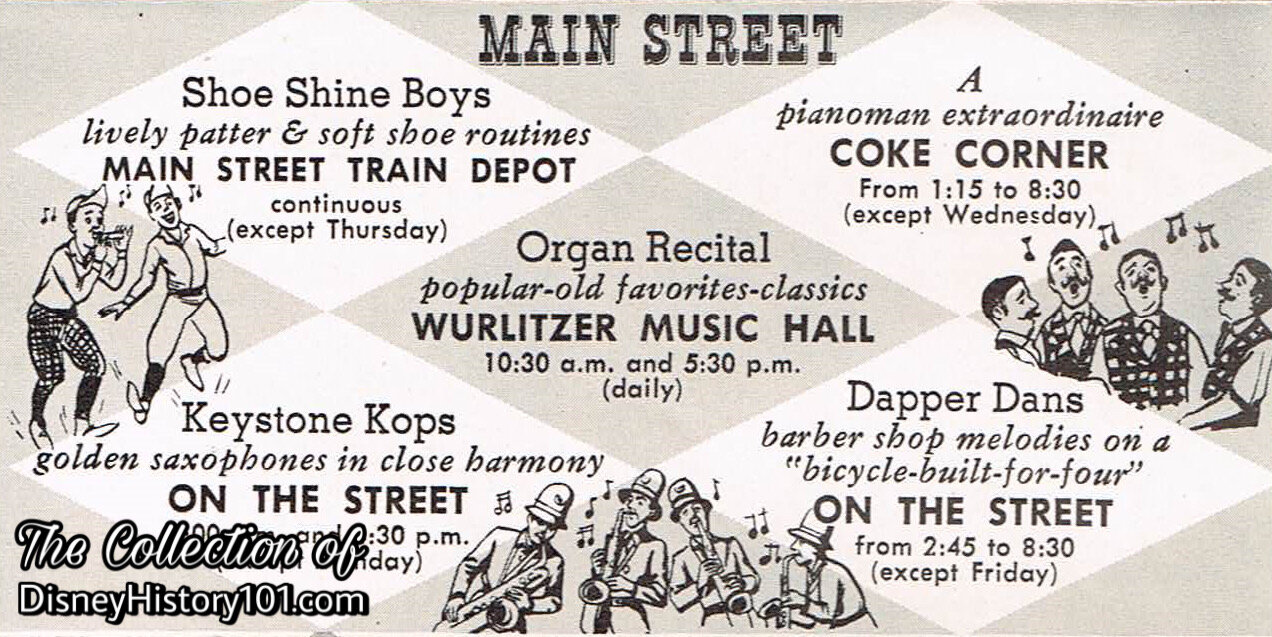
“Disneyland’s Happiest Show on Earth” Guide
During the 1960s, Entertainment Guides continued to regularly advertise the “Organ Recital - popular-old favorites-classics” often performed by Wurlitzer Manager D. R. “Dee” Fisher, in the Wurlitzer Music Hall, several times daily at both 10:30 a.m. and 5:30 p.m. These tunes were still piped through the shop via Grado Lab “Jr.” wall mounted speakers, and were once even “broadcast over Disneyland’s public address system” during the late afternoon, according to one article published in Disneyland Holiday (Summer, 1957).
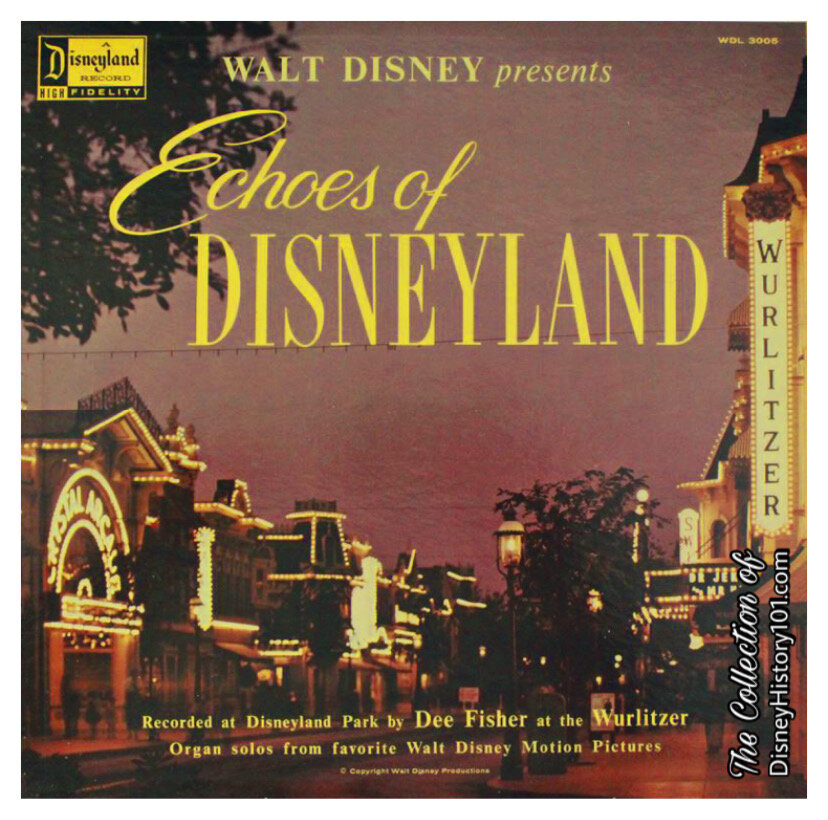
“Quiet Please, Broadcasting In Disneyland”
Thirteen of Mr. Dee Fisher’s electronic organ solos were even recorded and released on a “High Fidelity” album - “Echoes of Disneyland” published thru Disneyland Records, 1957. This practice of Disneyland’s featured artists (like the Strawhatters, the Yachtsmen, and others) recording albums was commonplace during the 1950s and 1960s. All of Dee’s recorded album tracks are renditions of popular songs once featured in Walt Disney Productions theatrical releases :
(1) Second Star to the Right (Peter Pan)
(2) Little April Shower (Bambi)
(3) A Dream is A Wish Your Heart Makes (Cinderella)
(4) Blue Shadow on the Trail (Melody Time)
(5) Bella Notte (Lady and the Tramp)
(6) La La Lu (Lady and the Tramp)
(7) Some Day My Prince Will Come (Snow White and the Seven Dwarfs)
(8) When You Wish Upon A Star (Pinocchio)
(9) Two Silhouettes (Make Mine Music)
(10) Lavender Blue (So Dear to My Heart)
(11) One Song (Snow White and the Seven Dwarfs)
(12) Alice in Wonderland
(13) Love is A Song (Bambi)
Guests who were interested in bringing the sound of “the happiest place on earth” home with them, could find Dee’s fine-quality and Hi-fidelity album for sell at the Wonderland Music Shop next door. Owning to Dee’s record album, his reputation as a “celebrated West Coast organist” preceded him, even outside Disneyland. The photograph of Dee (pictured above) was given as a personal gift (upon request) to the owner of Larry Bray’s Organ Loft of Salt Lake City, Utah in 1962.
In addition to Dee, other entertainers occasionally performed for Wurlitzer Music Hall guests, like the Dapper Dans. The Disneyland Christmas Carolers (under the direction of Dr. Charles C. Hirt and lead by Mr. Robert G. Hasty), were also known to perform at “Wurlitzer” during various times of the day, from December 16th, 1967 thru January 1st, 1968. [“Disneyland Holiday Talent Master Schedule,” prepared for the period of December 16, 1967 through January 1, 1968]
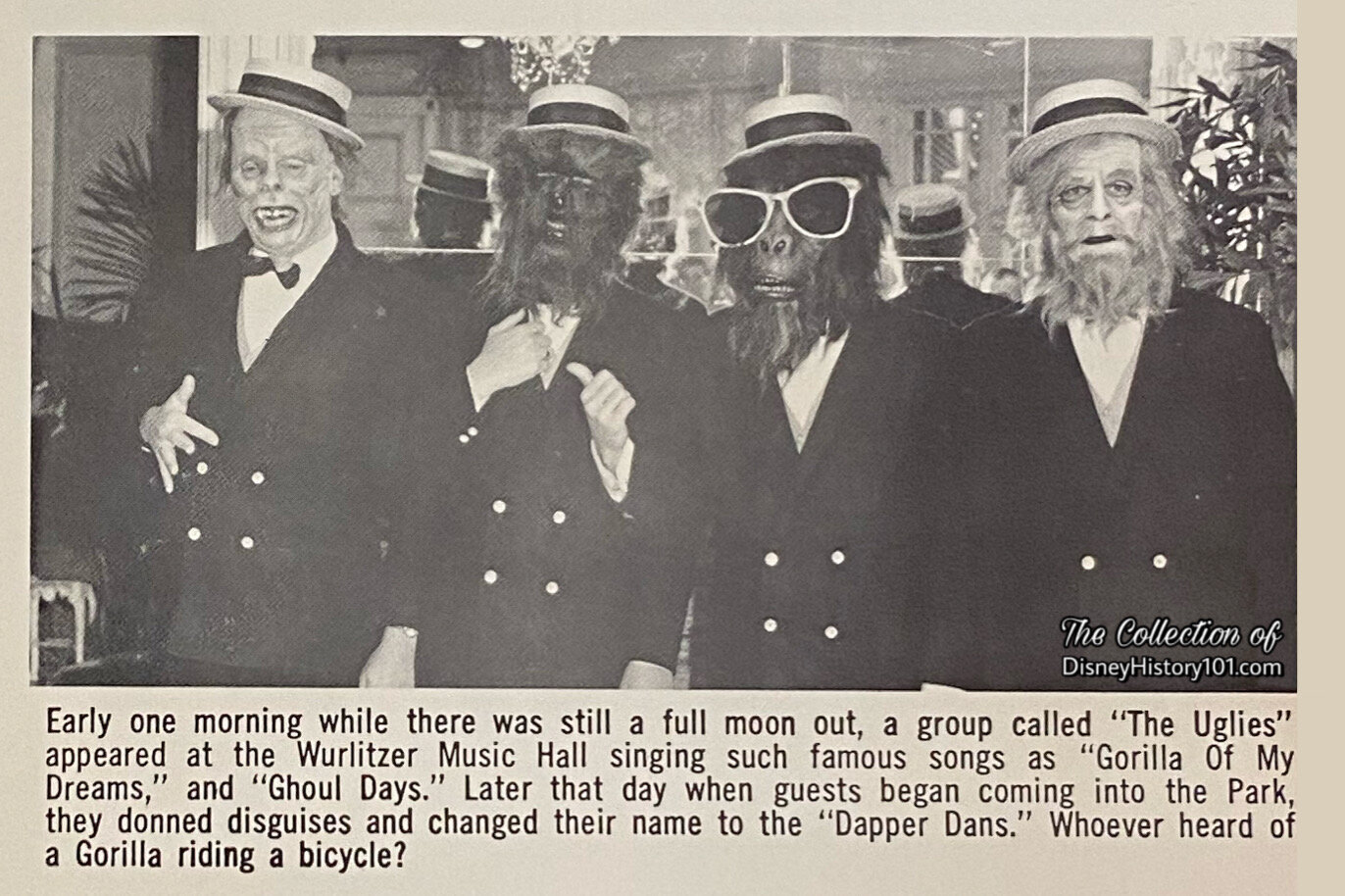
“The Uglies” make an appearance in Wurlitzer at Disneyland in a Disneyland Backstage Excerpt, Spring, 1966.
Dee wasn’t the only one to cut an album. Wurlitzer Music Hall Manager Mr. Don Beamsley (pictured earlier) recorded an album with Jud de Naut and June Rudell in 1962. This he did while working two jobs, one which was performing piano concerts for guests in a demonstration of popular organ models in the showroom. Wurlitzer Manager Don Beamsley was also known to be “the life of the party” and also occasionally performed at the Gourmet Restaurant with his group, as well as locations outside Disneyland. As far back as the Winter of 1962, he also performed at Hurrah’s of Lake Tahoe.
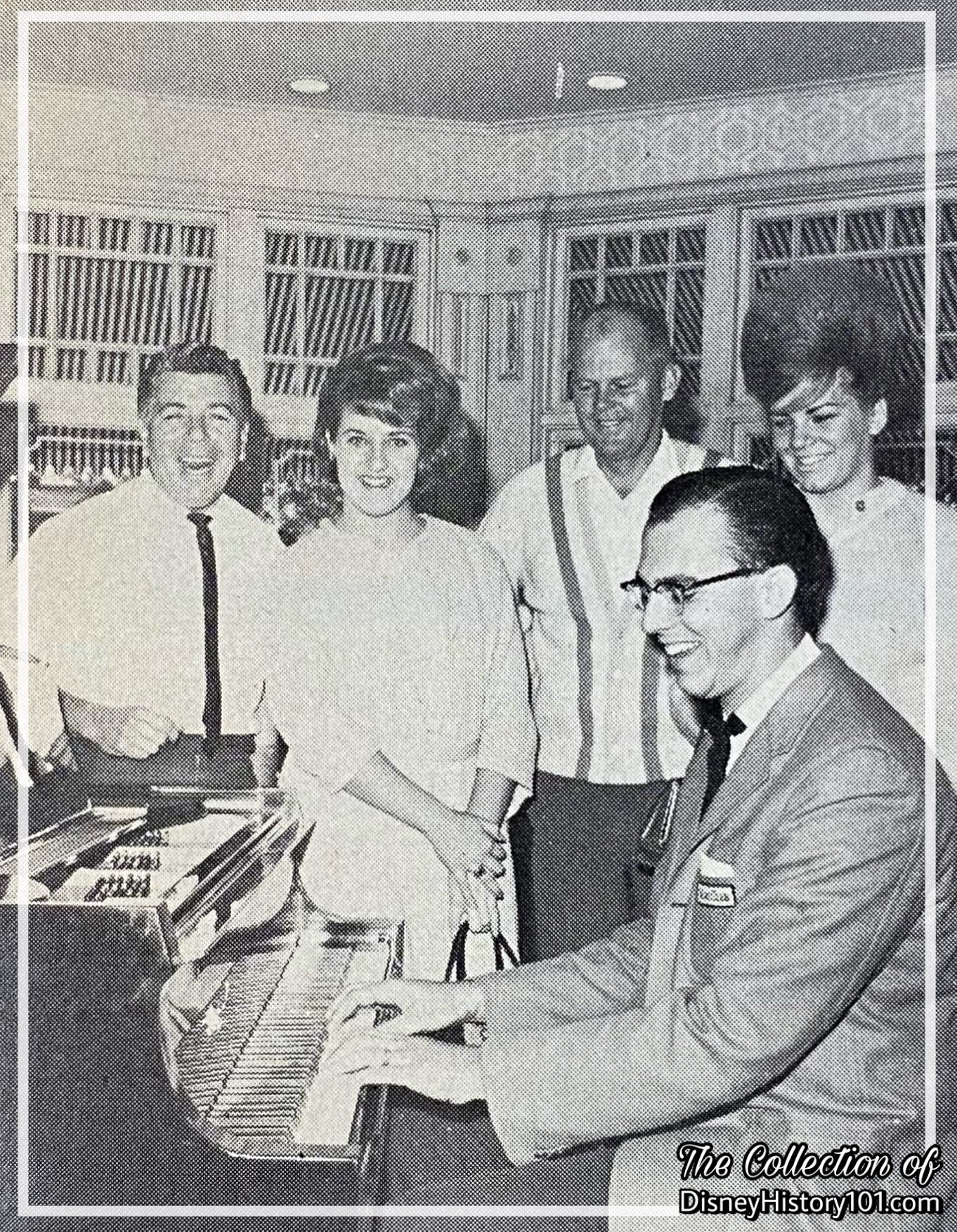
“Around the Wurlitzer piano,” Vacationland Winter/Spring 1965.
Many photos of Don Beamsley (and friends around a Wurlitzer piano) were published in coordination with the Disneyland Tencennial Celebration, for various newspaper inserts and publications like Vacationland magazine (Winter/Spring, 1965).
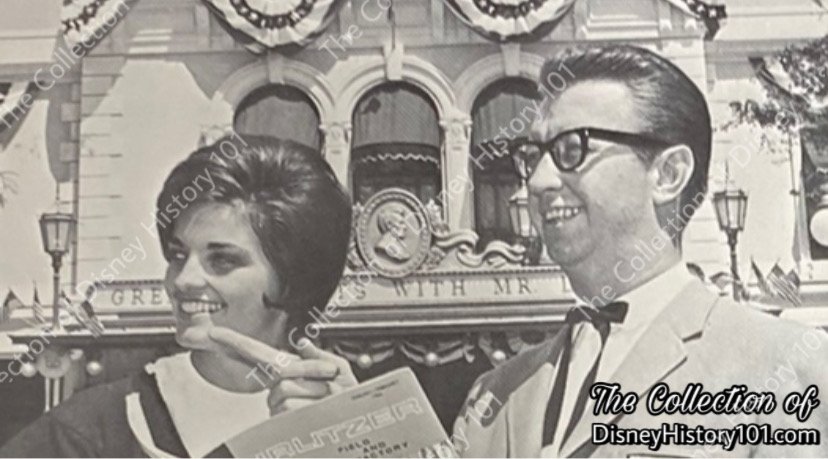
Carol Williamson and Don Beamsley in Backstage Disneyland, 1965.

c. 1960's.
In another rare unpublished view of Wurlitzer Music Hall, Manager Mr. Don Beamsley and Hostesses Carol Williamson.

Wurlitzer Management, c. 1960's.
In a rare (unpublished press photograph) “Vintage View” of Disneyland, (left to right) we see Z.B. Ross, (Wurlitzer Music Hall Owner and Manager) Mr. Don Beamsley (Disneyland Wurlitzer Music Hall Owner and Manager), and Walt Peteet standing for the camera in Town Square!
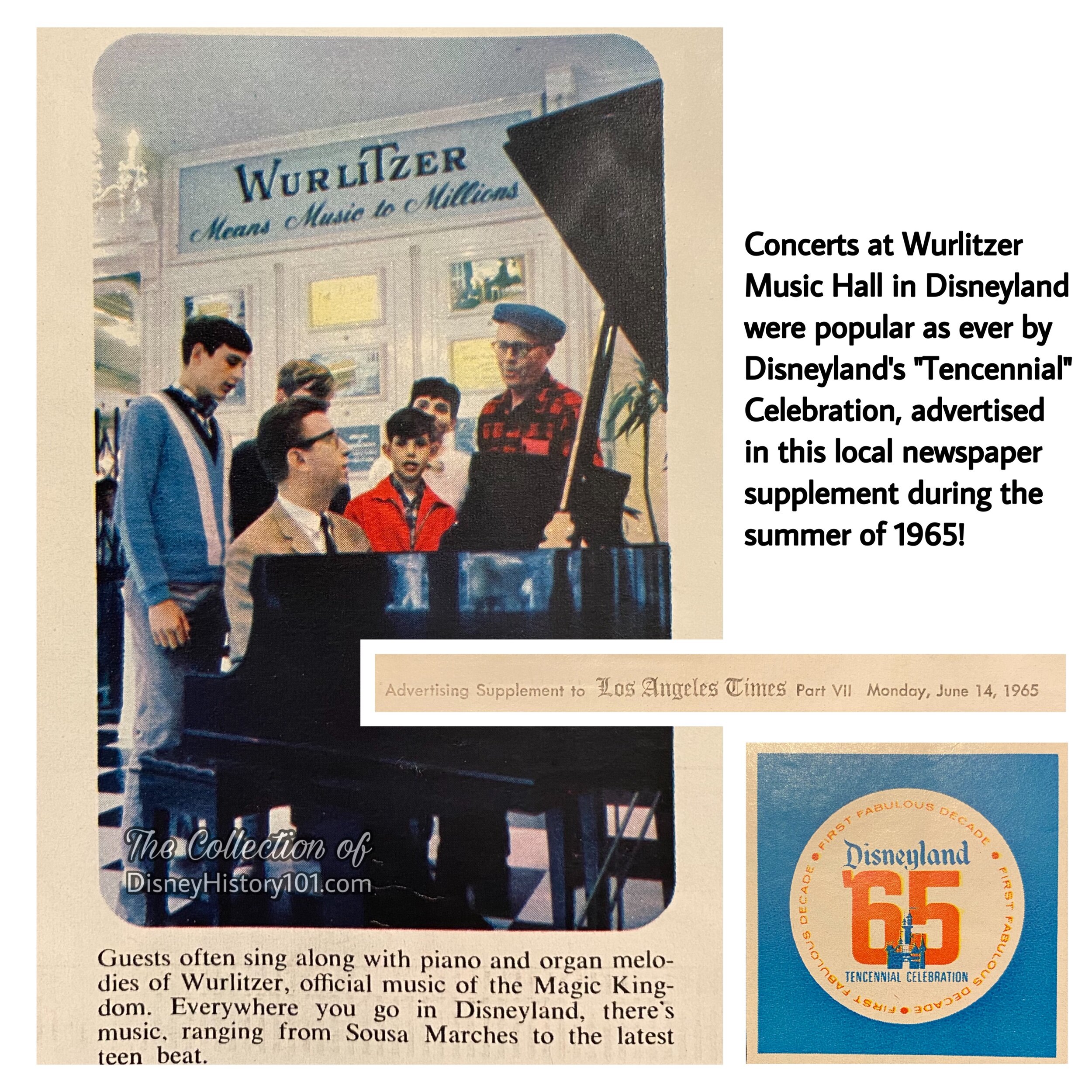
Mr. Beamsley serenades guests in a Los Angeles Times Newspaper Advertisement Supplement section, (June 14, 1965)
Sometime after the previous photo was prepared for the Tencennial insert, Mr. Don Beamsley began his career playing the organ for Dodger Stadium, during August of 1966 (before the World Series was held).
While the Wurlitzer name was associated with Disneyland, Disneyland did not exclusively make use of Wurlitzer brand pianos for its Shows. For instance (on October 19th, 1966), a meeting was held with Brian Whitman (of Whitman Piano Company) over the “purchase of piano dollys, rehab of pianos and purchase of a Grand Piano and other accessory equipment for Disneyland,” according to the recollections of Ben Harris. Then there is the story of the German J.C. Neupert harpsichord (or “Fortepiano”), which was hand-picked by Lillian Disney from the Kasimoff Blüthner Piano Company of Los Angeles, for Club 33.
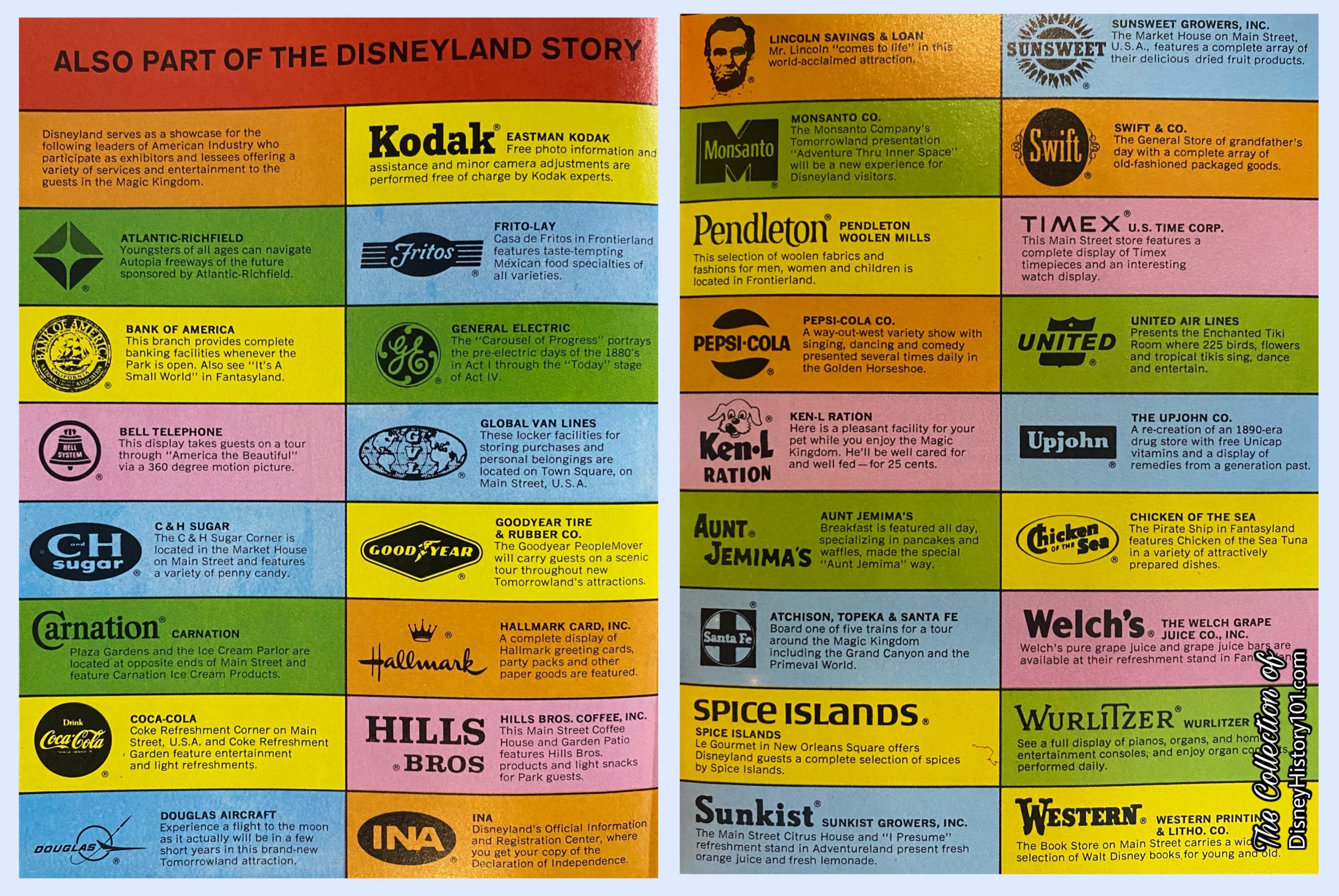
Wurlitzer was a Disneyland Participant and thus “part of the Disneyland story according to this “Disneyland ‘67” Excerpt.
Walt’s 65th birthday fell on December 5, 1966. It was about this time, that the unexpected occurred, ten days later, on Thursday, December 15, 1966, at 9:35 a.m., when a brother, a friend, and a leader, Walt Disney passed. Many Disney personnel who were present, remember this tragedy. Soon after, Roy O. Disney, President and Chairman of the Board of Walt Disney Productions addressed the staff with an official statement, in which it was conveyed:
“Walt Disney spent his entire life and almost every waking hour in the creative planning of…Disneyland… and the other diversified activities that have carried his name through the years. Around him Was Disney gathered the kind of creative people who understood his ways were always unique and he built a unique organization. A team of creative people that he was justifiably proud of… Many have been with us for over thirty years. They take great pride in the organization which we helped to build. Only through the talent, labor and dedication of this staff could any Disney project get off the ground… Much of Walt Disney’s energies had been directed to preparing for this day. It was Walt’s wish that when the time came he would have built an organization with the creative talents to carry on as he established and directed it through the years. Today this organization has been built and we will carry out this wish. Walt Disney’s preparation for the future has a solid, creative foundation. All of the plans for the future that Walt had begun… the expansion of Disneyland… will continue to move ahead.” Even Walt was so confident in his people to “move ahead,” once stating in a Canadian broadcast interview: “I think they’re going to stay with that policy because it’s a good business policy… I think they’ll hang on… well after Disney.”
Despite the loss of Walt (and all the competition), the Wurlitzer show went on - their organs were still popular around Disneyland during the winter season of 1967. If you visited Disneyland at that time, you may recall the sound of festive holiday “Organ Concerts” emanating from Carnation Plaza for 3 shows daily (10:30am-12:00N), from December 16th, 1967 thru January 1st, 1968 (except December 24th, 25th, and 31st, 1967). “Guests dining at the Garden Plaza” would “be entertained by the beautiful sounds of the Wurlitzer organ featuring Ray Whitaker at the keyboard.” [“Disneyland Holiday Talent Master Schedule,” prepared for the period of December 16, 1967 through January 1, 1968]
Alas, during September of 1968 (some three years after this previous photograph was taken ; a little over 13 years after the Wurlitzer name was first associated with Disneyland), the opening day sponsor departed from Disneyland. There were no comparable sponsors to fill the void left by this unique shop and free exhibit, and thus no “echoes” to be heard of the Wurlitzer name in Disneyland.
It was about this time (1968), that a new exhibit was in the planning stages, “Walt Disney - A Legacy for the Future.”
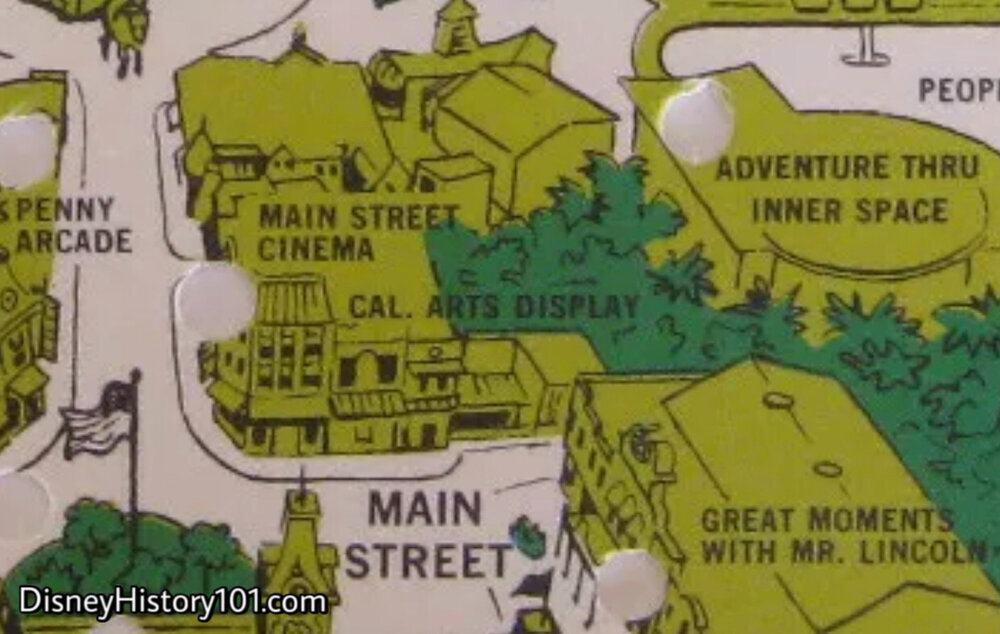
Dial Guide to the Magic Kingdom, 1970
Note the “Cal Arts Display” in this location c. 1970. Disneyland now utilized the vacant space to present special Park and company-related exhibits, beginning with “Walt Disney - A Legacy for The Future” (which opened January 15th, 1970). Walt Disney - A Legacy For the Future was an unstaffed “multi-screen show and display presenting Walt Disney’s endeavors in the fields of art and education. Included are plans for his cherished dream, California Institute for the Arts, and the first public display of all 29 Academy Awards received during his lifetime.” The exhibit would also display some “208 other awards,” according to Disneyland Line.
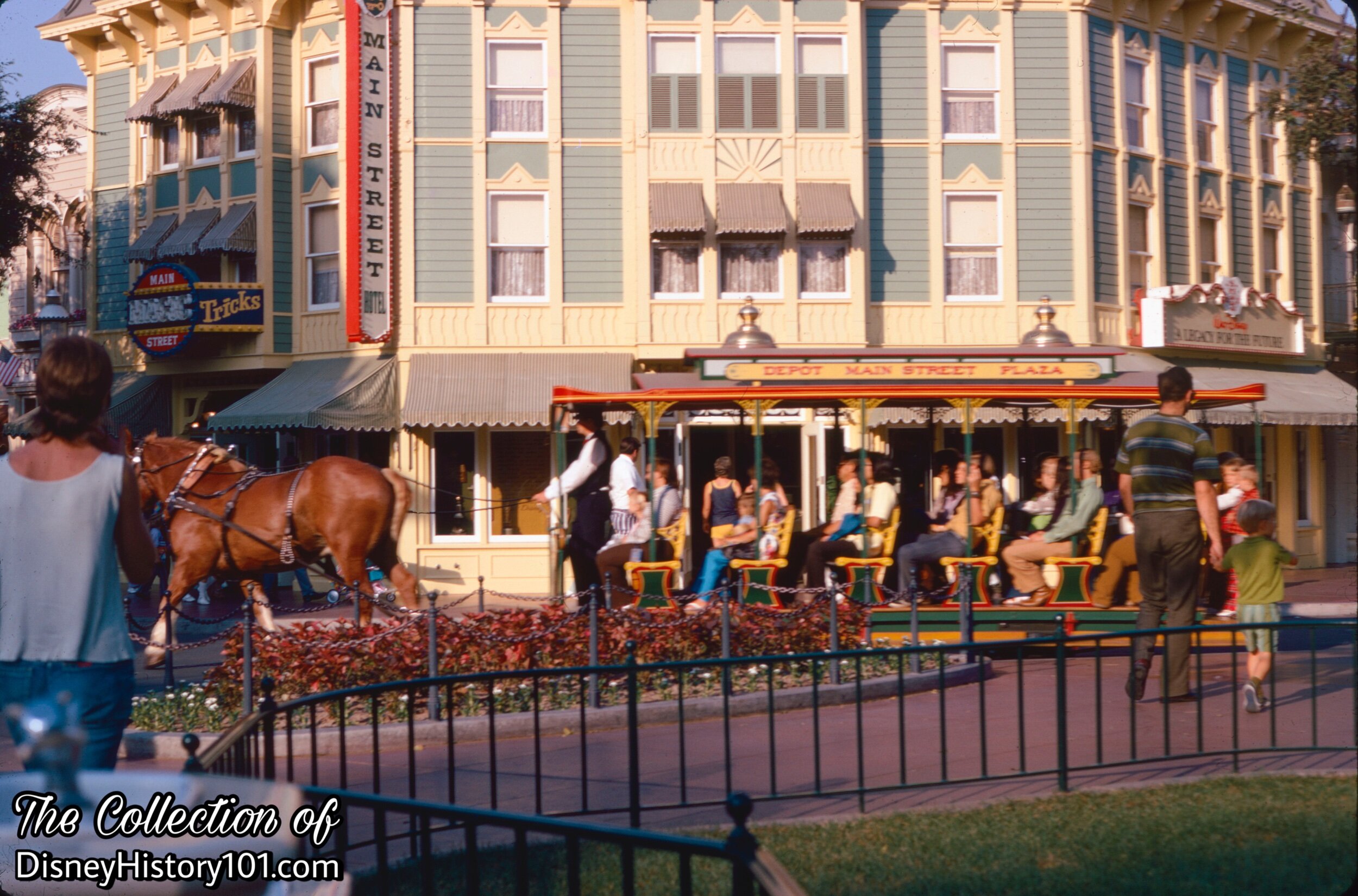
“Walt Disney - A Legacy for the Future,” 1970-1972.
By the summer of 1972, Walt Disney - A Legacy for the Future was still reckoned as one of Disneyland’s Free Exhibits and Shows (meaning that no admission coupon was required for entry). The Walt Disney Legacy for The Future” exhibit included artifacts like Walt’s special Academy Award for Snow White and the Seven Dwarfs.
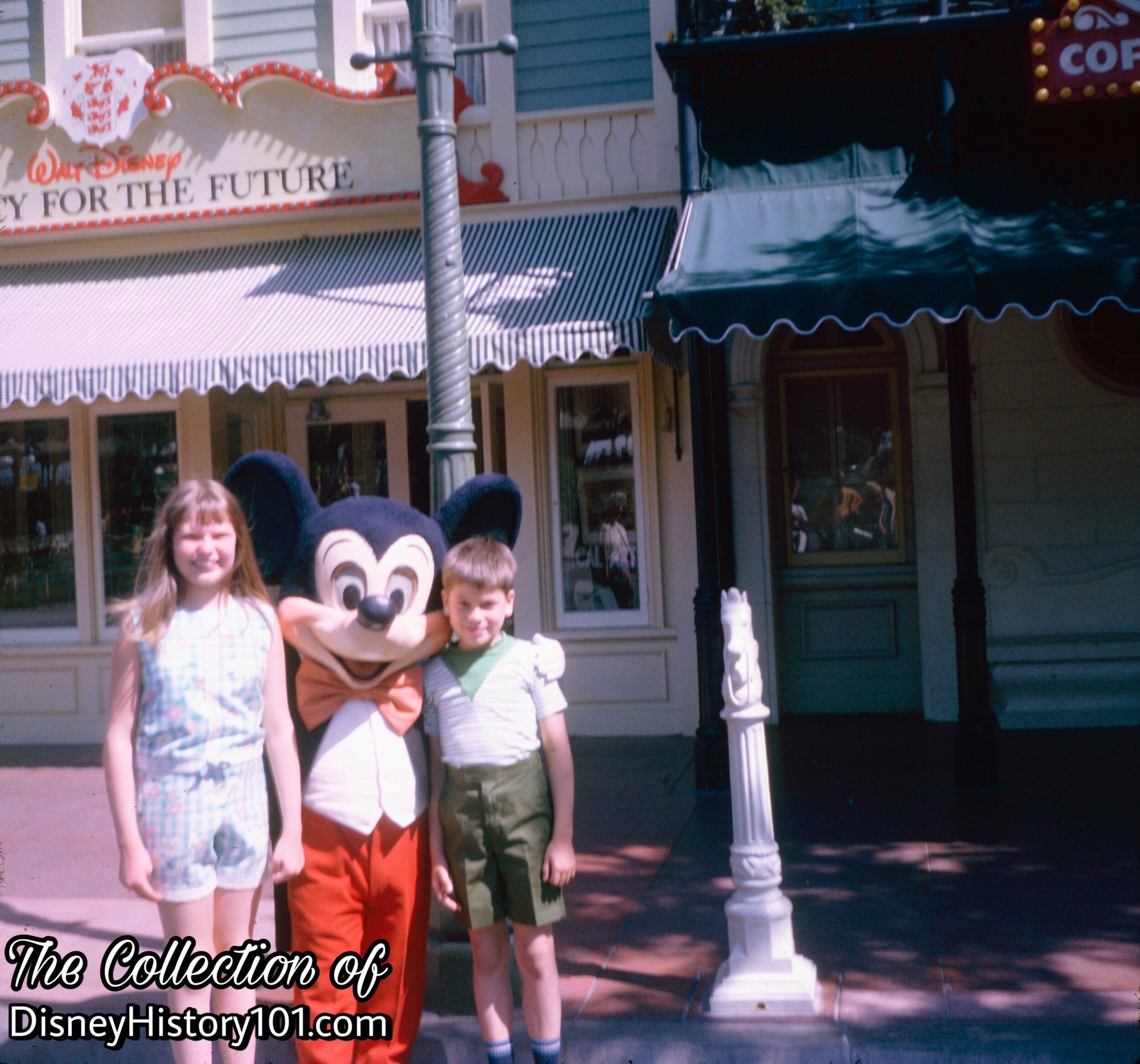
“Walt Disney - A Legacy for the Future,” 1970-1972.
After "Walt Disney - A Legacy for the Future" closed, another exhibit opened - “Disneyland Presents a Preview of Coming Attractions” (also known as the “Disneyland Preview Center” and the “Disneyland Showcase”), for some 15 years, from October of 1973. The free exhibit featured “artists renderings and models of future attractions planned for Disneyland,” as well as “other Corporate projects such as Tokyo Disneyland or the Disney Channel,” according to Disneyland LINE Magazine, September 5, 1985 ; Vol. 17, No. 36. You may recall seeing models, renderings and videos of “coming attractions” like Captain EO, Discovery Bay, Splash Mountain, the Hall of Presidents (for Disneyland), America Sings, Space Mountain, and New Fantasyland on exhibition. Other exhibits showcased films, Disney television shows, and Disney Channel programs.

Sam McKim Disneyland Map Wurlitzer Building Excerpts
From the Wurlitzer Music Hall to a vacant exhibit hall, to “Walt Disney Legacy” exhibit - souvenir Disneyland Maps capture the eras of this prime piece of Main Street U.S.A. real estate!
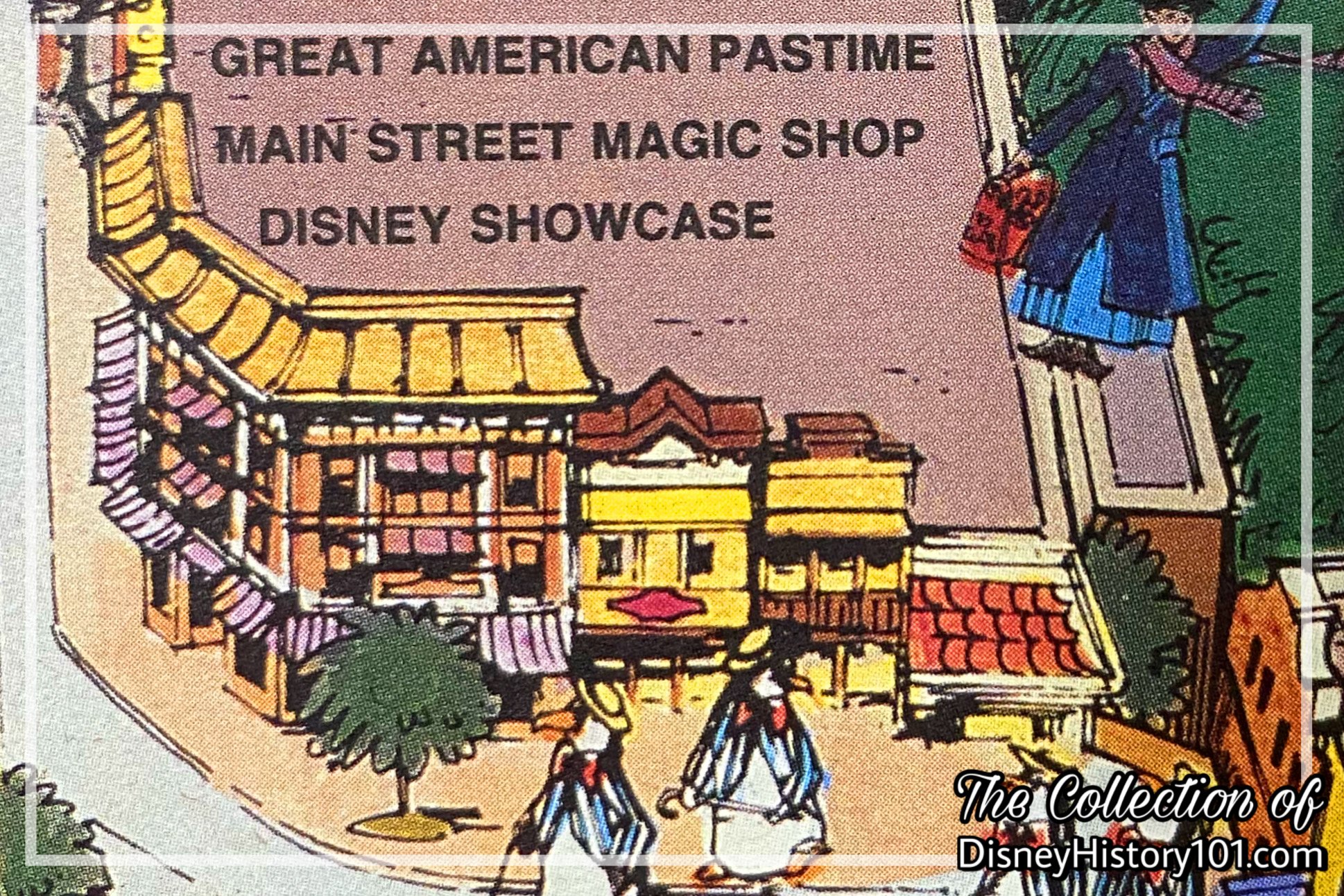
“Disneyland Showcase” in a Map Excerpt by Nina Rae Vaughn
In 1989, the Disney Showcase shop opened, offering merchandise tied to Walt Disney motion pictures, television shows, and Disney Channel programs including “Who Framed Roger Rabbit, Chip ‘n’ Dale’s Rescue Rangers, The Little Mermaid, and The Mickey Mouse Club,” according to Disneyland Line (September 4, 1992; Vol.24, No.36). You may remember discovering mugs, t-shirts, and other merchandise featuring “Walt Disney Pictures’ Beauty and the Beast” or Earl Sinclair and the Baby from “Jim Henson’s Dinosaurs” at the Disney Showcase about this time.
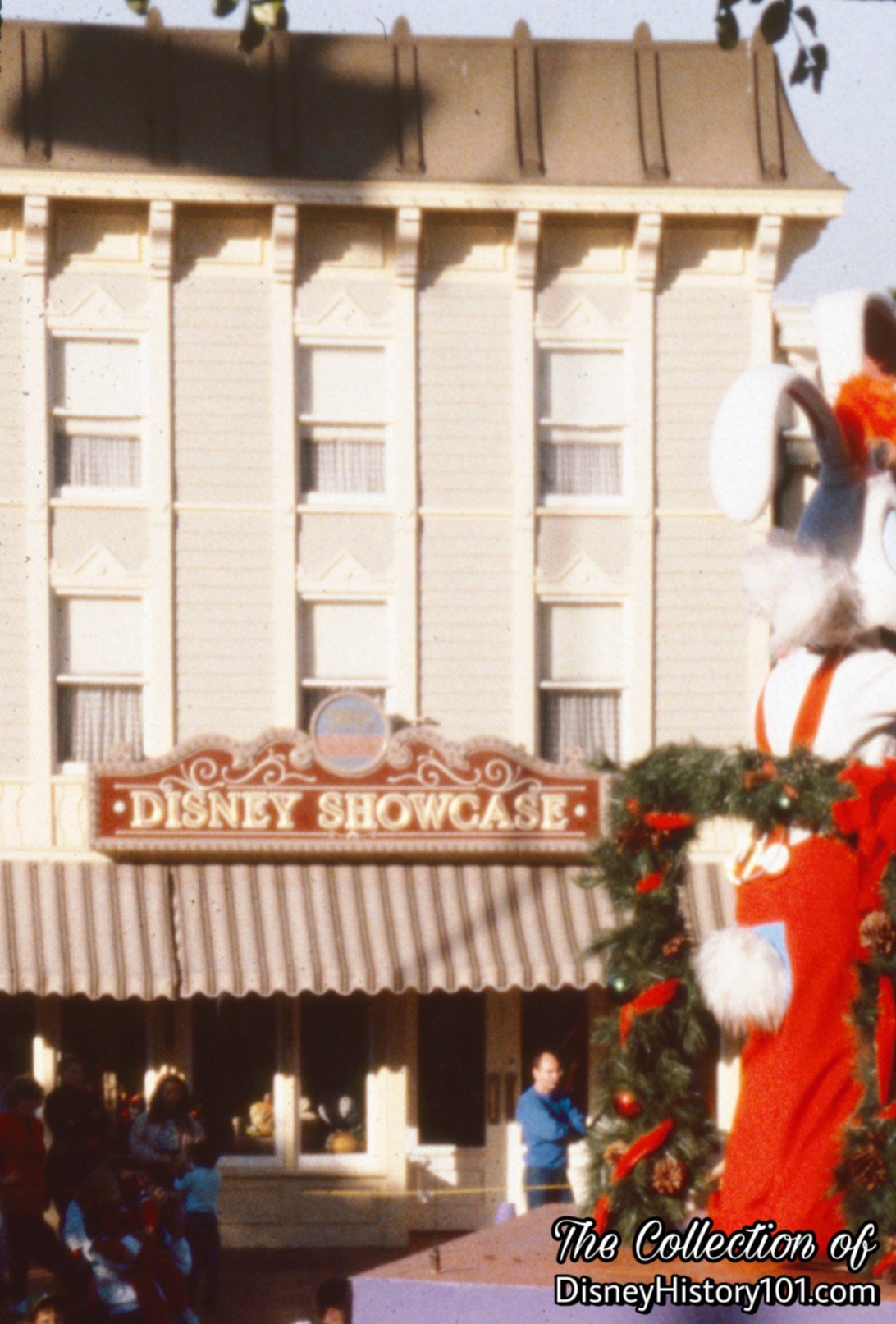
Disney Showcase
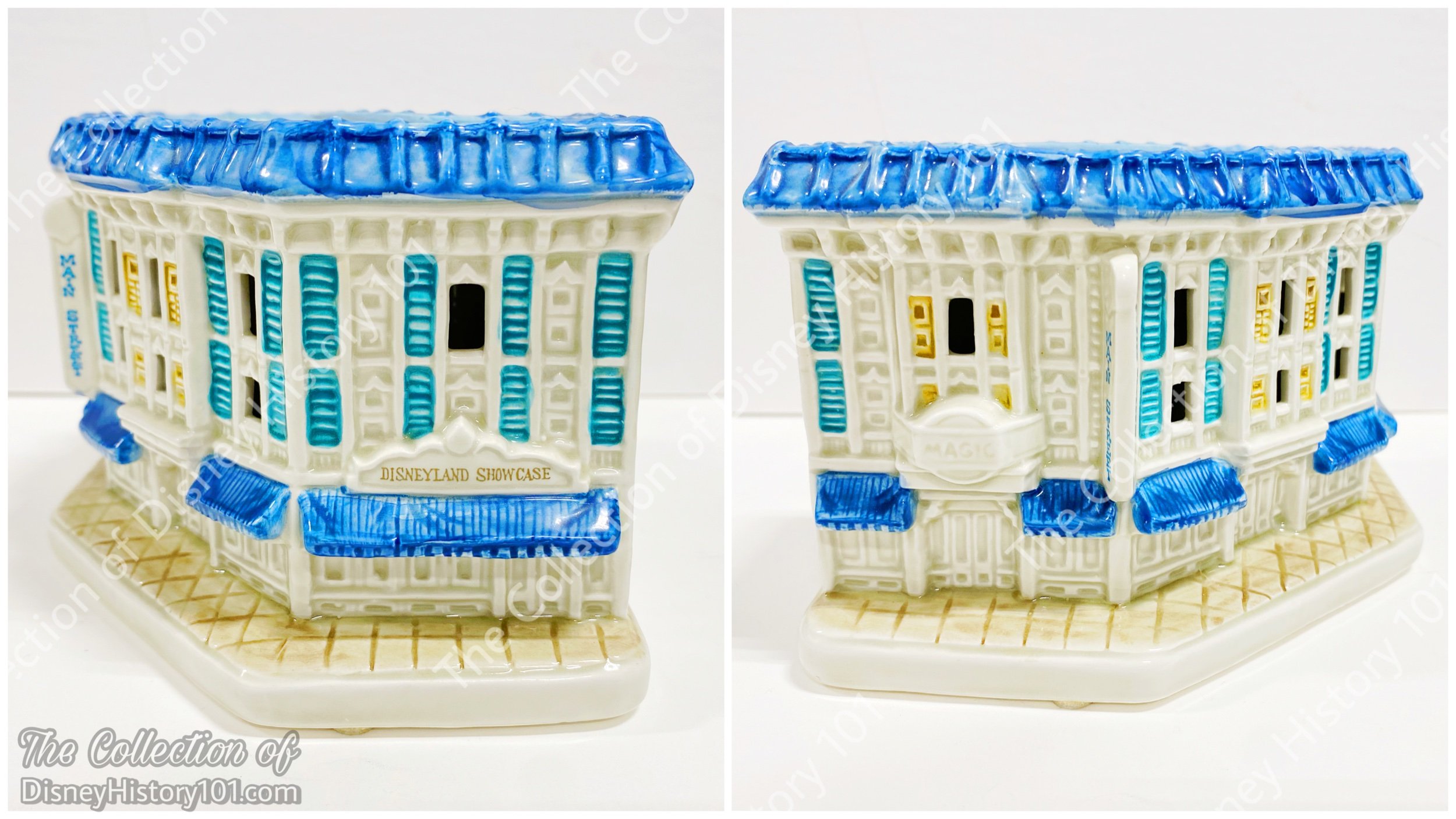

Aerialists over Main Street Hotel during Circus Fantasy, (1986)
The location and design of the Wurlitzer building itself allowed it to be utilized for many different events. Trooper Lights and Camera men were often perched from the roof, as during the opening day parade in 1955, or Holiday Festivals of Disneyland’s “Fabulous First Decade.” During Disneyland’s American Bicentennial celebration of (1975 to 1976), Parade Coordinator Don Payne was stationed atop the former Wurlitzer building because it offered a great aerial view of the route and crowds. He recollects about this vantage : “The parade would step off and we would all have stop watches with lights, sound cues, and synchronized watches. I was on top of Wurlitzer when Hirohito visited and there was all kind of SWAT and security on the rooftops and in the crowds. The SWAT officer told me ‘If I say drop, you drop. If you don’t drop, I’ll have to shoot through you.’ They took guest security very seriously.” Long after the Wurlitzer name had departed from Main Street U.S.A., the rooftops of the former free exhibit became the site of free shows. During Circus Fantasy (1986), while the sounds of the circus calliope organ would pass through the street, High-Wire performance artists walked a tightrope which was connected to the former Wurlitzer building’s roof (pictured above).
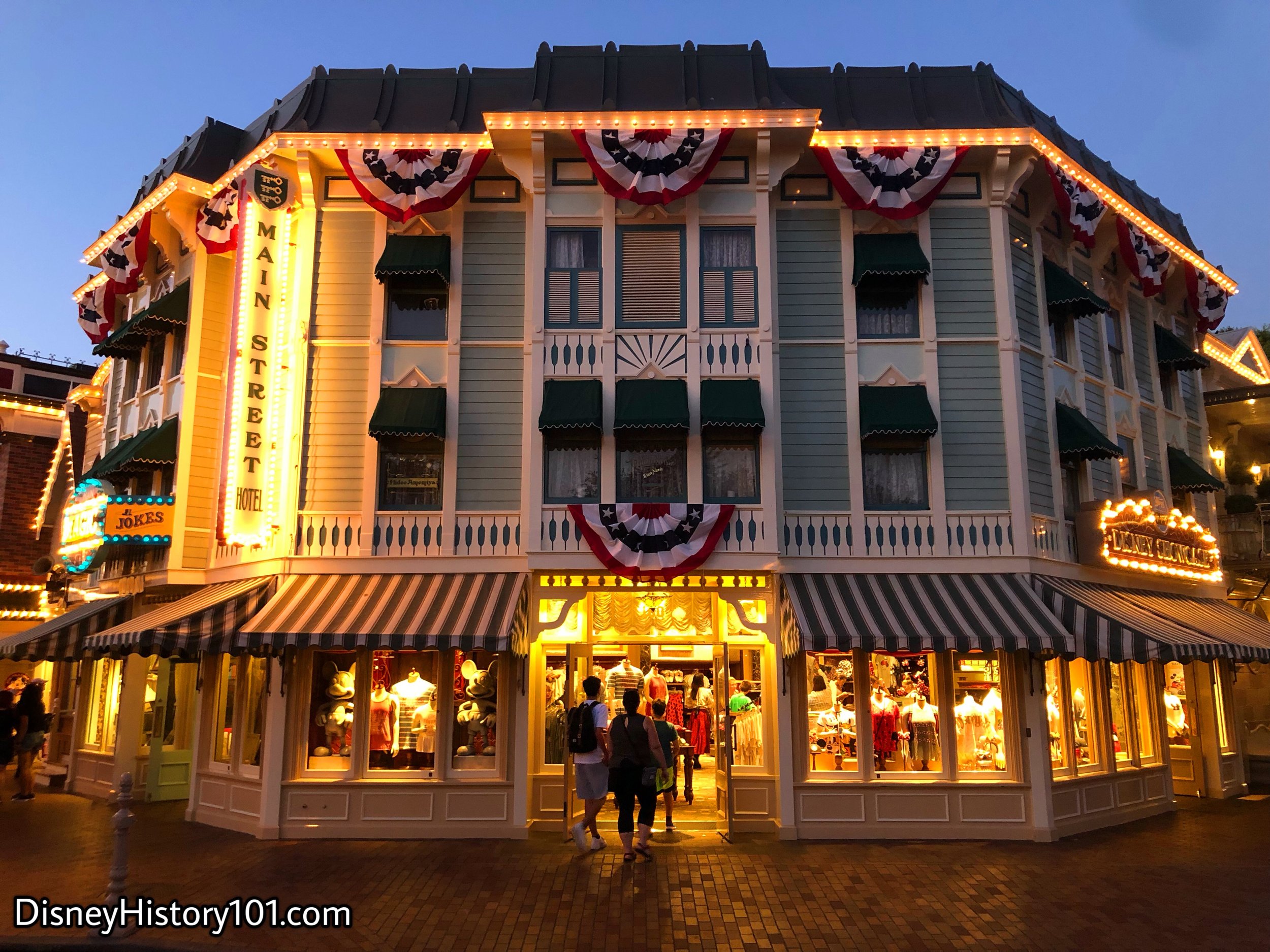
Main Street Hotel Building Architectural Facade, (2019)
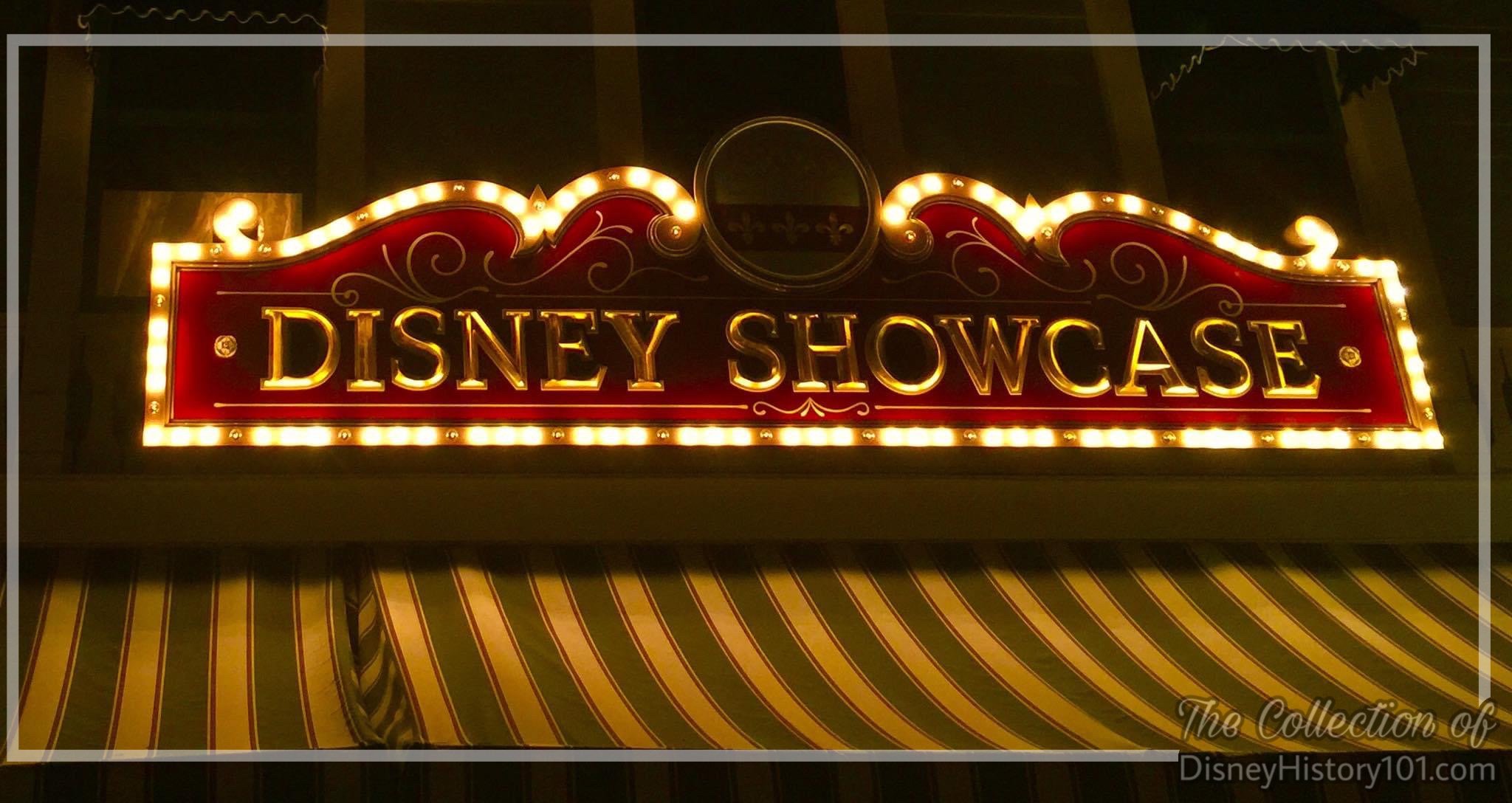
Disney Showcase Sign
Well, it looks like we’ve come upon the old Wurlitzer corner store building as it stands today during the twilight hours - not a note of the previous exhibits or lessees. Currently, beneath the Main Street Hotel sits the Disney Showcase Shop - home of seasonal merchandise since 1989.

